Towards a Real-Time Description of the Ionosphere: A Comparison between International Reference Ionosphere (IRI) and IRI Real-Time Assimilative Mapping (IRTAM) Models
Abstract
1. Introduction
2. IRI and IRTAM Models: A Brief Recall
2.1. IRI
2.2. Real-Time IRI and the IRTAM Method
3. Measured and Modeled Data Used for Validation
3.1. Observations from Ground-Based Ionosondes
- Low solar activity (LSA): F10.781 < 80 s.f.u. (solar flux units, 1 s.f.u. = 10−22 Wm−2 Hz−1).
- Mid solar activity (MSA): 80 s.f.u. ≤ F10.781 < 120 s.f.u.
- High solar activity (HSA): F10.781 ≥ 120 s.f.u.
3.2. Observations from Space-Based COSMIC/FORMOSAT-3 Satellites
3.3. IRI and IRTAM Models Runs
4. Methodologies of Analysis
4.1. Statistical Metrics Adopted in the Validation Process
4.2. Data Binning
- Data were binned as a function of the LT with fifteen minute-wide bins (96 bins in total).
- Data were collected in three separate diurnal sectors as a function of the solar zenith angle (SZA):
- Daytime: SZA ≤ 80°.
- Solar terminator: 80° < SZA < 100°.
- Nighttime: SZA ≥ 100°.
- (only for ionosondes) Data were binned as a function of the month of the year (12 bins in total).
- (only for COSMIC) Data were binned as a function of the day of the year (doy) in bins five-day wide (73 bins in total).
- Data were collected in four bins representative of the four seasons. Specifically, bins centered at equinoxes and solstices:
- March Equinox: 35 ≤ doy ≤ 125.
- June Solstice: 126 ≤ doy ≤ 217.
- September Equinox: 218 ≤ doy ≤ 309.
- December Solstice: doy ≤ 34 OR doy ≥ 310.
- Quiet magnetic activity: ap < 20 nT.
- Moderate magnetic activity: 20 nT ≤ ap < 100 nT.
- Disturbed magnetic activity: ap ≥ 100 nT.
- Data were binned as a function of the geographic coordinates in bins that are 2.5°-wide in latitude and 5°-wide in longitude.
- Data were binned as a function of the modip latitude in bins that are 2.5°-wide.
- Data were binned according to three ranges of modip values:
- Low modip: −30° < modip < 30°.
- Mid modip: −60° ≤ modip ≤ −30° AND 30° ≤ modip ≤ 60°.
- High modip: modip < −60° AND modip > 60°.
4.3. Graphical Representation of the Statistical Results
- Statistical distribution of residuals between measured and modeled (by IRI and IRTAM) foF2 and hmF2 values.
- Density plots between measured and modeled foF2 and hmF2 values, with the corresponding best linear fit line.
- Grids of Res. Mean, RMSE, and NRMSE values between measured and modeled foF2 and hmF2 values, as a function of the LT and the month of the year, for the three different levels of solar activity defined in Section 3.1.
- Geographic latitude vs. geographic longitude.
- Modip vs. LT hour.
- Modip vs. doy.
- Modip vs. F10.781.
5. Validation Results for foF2 Based on Ground-Based Ionosonde Observations
5.1. Statistics on the Full Dataset
5.2. Diurnal, Seasonal, and Solar Activity Statistics for Different Zonal Sectors
- Jicamarca (equatorial station, QD lat. = 0.2° N, Figure 4, Figure 5 and Figure 6): it was selected because among the stations with low modip (modip = 0.4° N) it is the one that presents the longest dataset (379,962 measurements); it has also the peculiarity of laying right above the magnetic equator.
- Ascension Island (low-latitude station, QD lat. = 19.1° S, Figure 7, Figure 8 and Figure 9): it was chosen because among the low-latitude stations characterized by a mid-low modip (modip = 34.3° S) it is the one that presents the longest dataset (264,916 measurements); it has also the particularity to lay over the southern equatorial anomaly crest.
- Rome (mid-latitude station, QD lat. = 35.9° N, Figure 10, Figure 11 and Figure 12): it was chosen because among the mid-latitude stations characterized by a mid modip (modip = 49.3° N) it is the one that presents the longest dataset, which is also the longest dataset among the 40 considered stations (520,519 measurements).
- Sondrestrom (high latitude, QD lat. = 72.2° N, Figure 13, Figure 14 and Figure 15): it was preferred among the stations with high modip (modip = 65.8° N) even if it presents a dataset that is a little bit shorter (200,111 measurements) than that of Tromso (259,000 measurements). The reason for this choice lies in the fact that Sondrestrom is significantly higher in latitude than Tromso (QD lat. = 66.5° N) and, thus, more representative of the auroral latitudes.
- Thule (polar cap, QD lat. = 84.5° N, Figure 16, Figure 17 and Figure 18): it was chosen among the stations with very high modip (modip = 72.7° N) because it provides a dataset (278,374 measurements) substantially larger than that of Nord Greenland (47,039 measurements), and also because of its proximity to the north pole.
6. Validation Results for foF2 Based on Radio Occultation Observations
7. Validation Results for hmF2 Based on Ground-Based Ionosonde Observations
7.1. Statistics on the Full Dataset
7.2. Diurnal, Seasonal, and Solar Activity Statistics Variations for Different Zonal Sectors
8. Validation Results for hmF2 Based on Radio Occultation Observations
9. Final Analyses and Comparisons between IRI and IRTAM
10. Conclusions
- When ionosonde observations are considered for validation, IRTAM improves significantly the IRI foF2 modeling while it slightly improves the IRI hmF2 modeling.
- When COSMIC observations are considered for validation, IRTAM improves neither the IRI foF2 modeling nor the IRI hmF2 modeling.
Author Contributions
Funding
Institutional Review Board Statement
Informed Consent Statement
Data Availability Statement
Acknowledgments
Conflicts of Interest
Abbreviations
| ap | Planetary 3-h-range ap magnetic index |
| C-Score | ARTIST Confidence Score |
| CCIR | Consultative Committee on International Radio |
| COSMIC | Constellation Observing System for Meteorology, Ionosphere and Climate/FORMOSAT-3 satellites |
| doy | Day of the year |
| F10.7 | Daily solar radio flux at 10.7 cm |
| F10.781 | 81-day running mean of the daily F10.7 |
| foF2 | Ordinary critical frequency of the F2-layer |
| GAMBIT | Global Assimilative Model of Bottomside Ionosphere Timeline |
| GIRO | Global Ionospheric Radio Observatory |
| GPS | Global Positioning System |
| hmF2 | Height of the F2-layer peak |
| HSA | High solar activity |
| IRI | International Reference Ionosphere |
| IRTAM | IRI Real-Time Assimilative Mapping |
| LSA | Low solar activity |
| LT | Local Time |
| M(3000)F2 | Ionospheric propagation factor |
| Modip | Modified dip latitude |
| MSA | Mid solar activity |
| NECTAR | Non-linear Error Compensation Technique for Associative Restoration |
| NRMSE | Normalized root mean square error |
| QD | Quasi Dipole |
| R | Pearson correlation coefficient |
| Rcw | Residuals deviation ratio parameter |
| Res. Mean | Mean of residuals |
| RMSE | Root mean square error |
| RMSPE | Root mean square percentage error |
| RO | Radio occultation |
| SZA | Solar zenith angle |
| vTEC | vertical Total Electron Content |
| URSI | International Union of Radio Science |
| UT | Universal Time |
References
- Moldwin, M. An Introduction To Space Weather; Cambridge University Press: Cambridge, MA, USA, 2008. [Google Scholar] [CrossRef]
- Cander, L.R. Ionospheric Space Weather; Springer Nature: Cham, Switzerland, 2019. [Google Scholar] [CrossRef]
- Schunk, R.W.; Scherliess, L.; Sojka, J.J.; Thompson, D.C.; Anderson, D.N.; Codrescu, M.; Minter, C.; Fuller-Rowell, T.J.; Heelis, R.A.; Hairston, M.; et al. Global assimilation of ionospheric measurements (GAIM). Radio Sci. 2004, 39. [Google Scholar] [CrossRef]
- Angling, M.J.; Khattatov, B. Comparative study of two assimilative models of the ionosphere. Radio Sci. 2006, 41. [Google Scholar] [CrossRef]
- Decker, D.T.; McNamara, L.F. Validation of ionospheric weather predicted by global assimilation of ionospheric measurements (GAIM) models. Radio Sci. 2007, 42, RS4017. [Google Scholar] [CrossRef]
- McNamara, L.F.; Decker, D.T.; Welsh, J.A.; Cole, D.G. Validation of the Utah State University global assimilation of ionospheric measurements (GAIM) model predictions of the maximum usable frequency for a 3000 km circuit. Radio Sci. 2007, 42, RS3015. [Google Scholar] [CrossRef]
- McNamara, L.F.; Bishop, G.J.; Welsh, J.A. Assimilation of ionosonde profiles into a global ionospheric model. Radio Sci. 2011, 46, RS2006. [Google Scholar] [CrossRef]
- Buresova, D.; Nava, B.; Galkin, I.; Angling, M.; Stankov, S.M.; Coisson, P. Data ingestion and assimilation in ionospheric models. Ann. Geophys. 2009, 52, 235–253. [Google Scholar] [CrossRef]
- Nava, B.; Coisson, P.; Radicella, S.M. A new version of the NeQuick ionosphere electron density model. J. Atmos. Sol. Terr. Phys. 2008, 70, 1856–1862. [Google Scholar] [CrossRef]
- Nava, B.; Radicella, S.M.; Azpilicueta, F. Data ingestion into NeQuick 2. Radio Sci. 2011, 46. [Google Scholar] [CrossRef]
- Pezzopane, M.; Pietrella, M.; Pignatelli, A.; Zolesi, B.; Cander, L.R. Assimilation of autoscaled data and regional and local ionospheric models as input sources for real-time 3-D international reference ionosphere modeling. Radio Sci. 2011, 46, 5009. [Google Scholar] [CrossRef]
- Pezzopane, M.; Pietrella, M.; Pignatelli, A.; Zolesi, B.; Cander, L.R. Testing the three-dimensional IRI-SIRMUP-P mapping of the ionosphere for disturbed periods. Adv. Space Res. 2013, 52, 1726–1736. [Google Scholar] [CrossRef][Green Version]
- Shim, J.S.; Kuznetsova, M.; Rastatter, L.; Hesse, M.; Bilitza, D.; Butala, M.; Codrescu, M.; Emery, B.; Foster, B.; Fuller-Rowell, T.; et al. CEDAR electrodynamics thermosphere ionosphere (ETI) challenge for systematic assessment of ionosphere/thermosphere models: NmF2, hmF2, and vertical drift using ground-based observations. Space Weather 2011, 9, S12003. [Google Scholar] [CrossRef]
- Pignalberi, A.; Pezzopane, M.; Rizzi, R.; Galkin, I. Effective solar indices for ionospheric modeling: A review and a proposal for a real-time regional IRI. Surv. Geophys. 2018, 39, 125–167. [Google Scholar] [CrossRef]
- Pietrella, M.; Pignalberi, A.; Pezzopane, M.; Pignatelli, A.; Azzarone, A.; Rizzi, R. A comparative study of ionospheric IRIEup and ISP assimilative models during some intense and severe geomagnetic storms. Adv. Space Res. 2018, 61, 2569–2584. [Google Scholar] [CrossRef]
- Pietrella, M.; Pezzopane, M.; Zolesi, B.; Cander, L.R.; Pignalberi, A. The simplified ionospheric regional model (SIRM) for HF prediction: Basic theory, its evolution and applications. Surv. Geophys. 2020, 41, 1143–1178. [Google Scholar] [CrossRef]
- Galkin, I.A.; Reinisch, B.W.; Huang, X.; Bilitza, D. Assimilation of GIRO data into a real-time IRI. Radio Sci. 2012, 47. [Google Scholar] [CrossRef]
- Galkin, I.A.; Reinisch, B.W.; Vesnin, A.M.; Bilitza, D.; Fridman, S.; Habarulema, J.B.; Veliz, O. Assimilation of sparse continuous near-Earth weather measurements by NECTAR model morphing. Space Weather 2020, 18, e2020SW002463. [Google Scholar] [CrossRef]
- Bilitza, D.; Altadill, D.; Truhlik, V.; Shubin, V.; Galkin, I.; Reinisch, B.; Huang, X. International reference ionosphere 2016: From ionospheric climate to real-time weather predictions. Space Weather 2017, 15, 418–429. [Google Scholar] [CrossRef]
- Bilitza, D. IRI the international standard for the ionosphere. Adv. Radio Sci. 2018, 16, 1–11. [Google Scholar] [CrossRef]
- Lei, J.; Syndergaard, S.; Burns, A.G.; Solomon, S.C.; Wang, W.; Zeng, Z.; Roble, R.G.; Wu, Q.; Kuo, Y.-H.; Holt, J.M.; et al. Comparison of COSMIC ionospheric measurements with ground-based observations and model predictions: Preliminary results. J. Geophys. Res. 2007, 112, A07308. [Google Scholar] [CrossRef]
- Damboldt, T.; Suessmann, P. Information document on the analysis and validity of present ITU foF2 and M (3000) f2 maps. Int. Telecommun. Union 2011. question ITU-R 212-1/3. Available online: http://www.itu.int/md/R07-WP3L-C-0086/en (accessed on 3 August 2021).
- Shim, J.S.; Tsagouri, I.; Goncharenko, L.; Rastaetter, L.; Kuznetsova, M.; Bilitza, D.; Codrescu, M.; Coster, A.J.; Solomon, S.C.; Fedrizzi, M.; et al. Validation of ionospheric specifications during geomagnetic storms: TEC and foF2 during the 2013 March storm event. Space Weather 2018, 16, 1686–1701. [Google Scholar] [CrossRef]
- Shim, J.S.; Kuznetsova, M.; Rastätter, L.; Hesse, M.; Bilitza, D.; Butala, M.; Codrescu, M.; Emery, B.; Foster, B.; Fuller-Rowell, T.; et al. CEDAR electrodynamics thermosphere ionosphere (ETI) challenge for systematic assessment of ionosphere/thermosphere models: Electron density, neutral density, NmF2, and hmF2 using space based observations. Space Weather 2012, 10, S10004. [Google Scholar] [CrossRef]
- Pedatella, N.M.; Yue, X.; Schreiner, W.S. Comparison between GPS radio occultation electron densities and in situ satellite observations. Radio Sci. 2015, 50, 518–525. [Google Scholar] [CrossRef]
- Pignalberi, A.; Pezzopane, M.; Tozzi, R.; De Michelis, P.; Coco, I. Comparison between IRI and preliminary Swarm Langmuir probe measurements during the St. Patrick storm period. Earth Planets Space 2016, 68. [Google Scholar] [CrossRef]
- Tsagouri, I.; Goncharenko, L.; Shim, J.S.; Belehaki, A.; Buresova, D.; Kuznetsova, M.M. Assessment of current capabilities in modeling the ionospheric climatology for space weather applications: foF2 and hmF2. Space Weather 2018, 16, 1930–1945. [Google Scholar] [CrossRef]
- Cai, X.; Burns, A.G.; Wang, W.; Coster, A.; Qian, L.; Liu, J.; Solomon, S.C.; Eastes, R.W.; Daniell, R.E.; McClintock, W.E.; et al. Comparison of GOLD nighttime measurements with total electron content: Preliminary results. J. Geophys. Res. Space Phys. 2020, 125, e2019JA027767. [Google Scholar] [CrossRef]
- Vesnin, A.M. Validation of F2 Layer Peak Height and Density of Real-Time International Reference Ionosphere. Master’s Thesis, University of Massachusetts Lowell, Lowell, MA, USA, 2014. Available online: https://ulcar.uml.edu/GAMBIT/Vesnin-Master-thesis-2014.pdf (accessed on 3 August 2021).
- Zolesi, B.; Cander, L.R. Ionospheric Prediction and Forecasting; Springer: Berlin/Heidelberg, Germany, 2014. [Google Scholar] [CrossRef]
- Rush, C.M.; Fox, M.; Bilitza, D.; Davies, K.; McNamara, L.; Stewart, F.G.; PoKempner, M. Ionospheric mapping-an update of foF2 coefficients. Telecommun. J. 1989, 56, 179–182. [Google Scholar]
- Jones, W.B.; Gallet, R.M. Representation of diurnal and geographical variations of ionospheric data by numerical methods. Telecommun. J. 1962, 29, 129–149. Available online: https://nvlpubs.nist.gov/nistpubs/jres/66D/jresv66Dn4p419_A1b.pdf (accessed on 3 August 2021).
- Jones, W.B.; Gallet, R.M. Representation of diurnal and geographic variations of ionospheric data by numerical methods, II. Control of instability. Telecommun. J. 1965, 32, 18–28. [Google Scholar]
- Jones, W.B.; Graham, R.P.; Leftin, M. Advances in Ionospheric Mapping by Numerical Methods; ESSA Technical Report ERL107-ITS75; US Department of Commerce: Boulder, CO, USA, 1969. Available online: https://www.govinfo.gov/content/pkg/GOVPUB-C13-4811417984235af8236e56a8e5d5d483/pdf/GOVPUB-C13-4811417984235af8236e56a8e5d5d483.pdf (accessed on 3 August 2021).
- CCIR Atlas of Ionospheric Characteristics Report 340; Consultative Committee on International Radio, International Telecommunication Union: Geneva, Switzerland, 1967.
- Rawer, K. Propagation of decameter waves (HF Band). In Meteorological and Astronomical Influences on Radio Wave Propagation; Landmark, B., Ed.; Academic Press: New York, NY, USA, 1963; pp. 221–250. [Google Scholar]
- Liu, R.; Smith, P.; King, J. A new solar index which leads to improved foF2 predictions using the CCIR atlas. Telecomm. J. 1983, 50, 408–414. [Google Scholar]
- Fuller-Rowell, T.J.; Araujo-Pradere, E.; Codrescu, M.V. An empirical ionospheric storm-time correction model. Adv. Space Res. 2000, 25, 139–146. [Google Scholar] [CrossRef]
- Araujo-Pradere, E.A.; Fuller-Rowel, T.J.; Codrescu, M.V. STORM: An empirical storm-time ionospheric correction model 1. Model description. Radio Sci. 2002, 37. [Google Scholar] [CrossRef]
- Araujo-Pradere, E.A.; Fuller-Rowell, T.J. STORM: An empirical storm-time ionospheric correction model 2. Validation. Radio Sci. 2002, 37, 1071. [Google Scholar] [CrossRef]
- Bilitza, D.; Sheik, N.; Eyfrig, R. A global model for the height of the F2-peak using M3000 values from the CCIR numerical map. Telecommun. J. 1979, 46, 549–553. [Google Scholar]
- Altadill, D.; Magdaleno, S.; Torta, J.M.; Blanch, E. Global empirical models of the density peak height and of the equivalent scale height for quiet conditions. Adv. Space Res. 2013, 52, 1756–1769. [Google Scholar] [CrossRef]
- Shubin, V.N.; Karpachev, A.T.; Tsybuly, K.G. Global model of the F2 layer peak height for low solar activity based on GPS radio-occultation data. J. Atmos. Sol. Terr. Phys. 2013, 104, 106–115. [Google Scholar] [CrossRef]
- Shubin, V.N. Global median model of the F2-layer peak height based on ionospheric radio-occultation and ground based digisonde observations. Adv. Space Res. 2015, 56, 916–928. [Google Scholar] [CrossRef]
- Bilitza, D.; Bhardwaj, S.; Koblinsky, C. Improved IRI predictions for the GEOSAT time period. Adv. Space Res. 1997, 20, 1755–1760. [Google Scholar] [CrossRef]
- Komjathy, A.; Langley, R.; Bilitza, D. Ingesting GPS-derived TEC data into the international reference ionosphere for single frequency radar altimeter ionospheric delay corrections. Adv. Space Res. 1998, 22, 793–802. [Google Scholar] [CrossRef]
- Hernandez-Pajares, M.; Juan, J.; Sanz, J.; Bilitza, D. Combining GPS measurements and IRI model values for space weather specification. Adv. Space Res. 2002, 29, 949–958. [Google Scholar] [CrossRef]
- Ssessanga, N.; Kim, Y.H.; Kim, E.; Kim, J. Regional optimization of the IRI-2012 output (TEC, foF2) by using derived GPS-TEC. J. Korean Phys. Soc. 2015, 66, 1599–1610. [Google Scholar] [CrossRef]
- Habarulema, J.B.; Ssessanga, N. Adapting a climatology model to improve estimation of ionosphere parameters and subsequent validation with radio occultation and ionosonde data. Space Weather 2016, 15, 84–98. [Google Scholar] [CrossRef]
- Pignalberi, A.; Pezzopane, M.; Rizzi, R.; Galkin, I. Correction to: Effective solar indices for ionospheric modeling: A review and a proposal for a real-time regional IRI. Surv. Geophys. 2018, 39, 169. [Google Scholar] [CrossRef]
- Pignalberi, A.; Pietrella, M.; Pezzopane, M.; Rizzi, R. Improvements and validation of the IRI UP method under moderate, strong, and severe geomagnetic storms. Earth Planets Space 2018, 70, 1–22. [Google Scholar] [CrossRef]
- Pignalberi, A.; Habarulema, J.B.; Pezzopane, M.; Rizzi, R. On the development of a method for updating an empirical climatological ionospheric model by means of assimilated vTEC measurements from a GNSS receiver network. Space Weather 2019, 17, 1131–1164. [Google Scholar] [CrossRef]
- Brunini, C.; Conte, J.F.; Azpilicueta, F.; Bilitza, D. A different method to update monthly median hmF2 values. Adv. Space Res. 2013, 51, 2322–2332. [Google Scholar] [CrossRef]
- Hopfield, J.J. Neural networks and physical systems with emergent collective computational abilities. Proc. Natl. Acad. Sci. USA 1982, 79, 2554–2558. [Google Scholar] [CrossRef]
- Laundal, K.M.; Richmond, A.D. Magnetic Coordinate Systems. Space Sci. Rev. 2017, 206, 27. [Google Scholar] [CrossRef]
- Reinisch, B.W.; Galkin, I.A. Global Ionospheric Radio Observatory (GIRO). Earth Planets Space 2011, 63, 377–381. [Google Scholar] [CrossRef]
- Bibl, K.; Reinisch, B.W. The universal digital ionosonde. Radio Sci. 1978, 13, 519–530. [Google Scholar] [CrossRef]
- Galkin, I.A.; Reinisch, B.W. The new ARTIST 5 for all digisondes. In Ionosonde Network Advisory Group (INAG) Bulletin, 69th ed.; International Radio Science Union: Ghent, Belgium, 2008; Available online: http://www.ursi.org/files/CommissionWebsites/INAG/web-69/2008/artist5-inag.pdf (accessed on 3 August 2021).
- Galkin, I.A.; Reinisch, B.W.; Huang, X.; Khmyrov, G.M. Confidence score of ARTIST-5 ionogram autoscaling. In Ionosonde Network Advisory Group (INAG) Bulletin, 73rd ed.; International Radio Science Union: Ghent, Belgium, 2013; Available online: http://www.ursi.org/files/CommissionWebsites/INAG/web-73/confidence_score.pdf (accessed on 3 August 2021).
- Tapping, K.F. The 10.7 cm solar radio flux (F10.7): F10.7. Space Weather 2013, 11, 394–406. [Google Scholar] [CrossRef]
- Anthes, R.A.; Bernhardt, P.A.; Chen, Y.; Cucurull, L.; Dymond, K.F.; Ector, D.; Healy, S.B.; Ho, S.-P.; Hunt, D.C.; Kuo, Y.-H.; et al. The COSMIC/FORMOSAT-3 mission: Early results. Bull. Am. Meteorol. Soc. 2008, 89, 313–333. [Google Scholar] [CrossRef]
- Pignalberi, A.; Pezzopane, M.; Nava, B.; Coisson, P. On the link between the topside ionospheric effective scale height and the plasma ambipolar diffusion, theory and preliminary results. Sci. Rep. 2020, 10, 17541. [Google Scholar] [CrossRef]
- Rostoker, G. Geomagnetic indices. Rev. Geophys. Space Phys. 1972, 10, 935–950. [Google Scholar] [CrossRef]
- Solomon, S.C.; Woods, T.N.; Didkovsky, L.V.; Emmert, J.T.; Qian, L. Anomalously low solar extreme-ultraviolet irradiance and thermospheric density during solar minimum. Geophys. Res. Lett. 2010, 37, 16. [Google Scholar] [CrossRef]
- Perna, L.; Pezzopane, M. foF2 vs solar indices for the Rome station: Looking for the best general relation which is able to describe the anomalous minimum between cycles 23 and 24. J. Atmos. Space Phys. 2016, 146, 13–21. [Google Scholar] [CrossRef]
- Lühr, H.; Xiong, C. The IRI 2007 model overestimates electron density during the 23/24 solar minimum. Geophys. Res. Lett. 2010, 37, L23101. [Google Scholar] [CrossRef]
- Ezquer, R.G.; López, J.L.; Scidá, L.A.; Cabrera, M.A.; Zolesi, B.; Bianchi, C.; Pezzopane, M.; Zuccheretti, E.; Mosert, M. Behavior of ionospheric magnitudes of F2 region over Tucumán during a deep solar minimum and comparison with the IRI2012 model predictions. J. Atmos. Sol. Terr. Phys. 2014, 107, 89–98. [Google Scholar] [CrossRef]
- Perna, L.; Pezzopane, M.; Ezquer, R.; Cabrera, M.; Baskaradas, J.A. NmF2 trends at low and mid latitudes for the recent solar minima and comparison with IRI-2012 model. Adv. Space Res. 2017, 60, 363–374. [Google Scholar] [CrossRef]
- Arıkan, F.; Sezen, U.; Gulyaeva, T.L. Comparison of IRI-2016 F2 layer model parameters with ionosonde measurements. J. Geophys. Res. Space Phys. 2019, 124, 8092–8109. [Google Scholar] [CrossRef]
- Mengist, C.K.; Yadav, S.; Kotulak, K.; Bahar, A.; Zhang, S.-R.; Seo, K.-H. Validation of International Reference ionosphere model (IRI-2016) for F-region peak electron density height (hmF2): Comparison with Incoherent Scatter Radar (ISR) and ionosonde measurements at Millstone Hill. Adv. Space Res. 2020, 65, 2773–2781. [Google Scholar] [CrossRef]
- Huang, H.; Moses, M.; Volk, A.E.; Abu Elezz, O.; Kassamba, A.A.; Bilitza, D. Assessment of IRI-2016 hmF2 model options with digisonde, COSMIC and ISR observations for low and high solar flux conditions. Adv. Space Res. 2021. [Google Scholar] [CrossRef]
- Titheridge, J.E. Ionogram Analysis with the Generalised Program Polan, Rep. UAG-93; World Data Center A for Solar-Terrestrial Physics: Boulder, CO, USA, 1985. [Google Scholar]
- Chen, C.F.; Reinisch, B.W.; Scali, J.L.; Huang, X.; Gamache, R.R.; Buonsanto, M.J.; Ward, B.D. The accuracy of ionogram-derived N(h) profiles. Adv. Space Res. 1994, 14, 43–46. [Google Scholar] [CrossRef]
- Hartman, W.A.; Schmidl, W.D.; Mikatarian, R.; Galkin, I. Correlation of IRTAM and FPMU data confirming the application of IRTAM to support ISS Program safety. Adv. Space Res. 2019, 63, 1838–1844. [Google Scholar] [CrossRef]
- Froń, A.; Galkin, I.; Krankowski, A.; Bilitza, D.; Hernández-Pajares, M.; Reinisch, B.; Li, Z.; Kotulak, K.; Zakharenkova, I.; Cherniak, I.; et al. Towards cooperative global mapping of the ionosphere: Fusion feasibility for IGS and IRI with global climate VTEC maps. Remote Sens. 2020, 12, 3531. [Google Scholar] [CrossRef]
- Themens, D.R.; Jayachandran, P.T.; Bilitza, D.; Erickson, P.J.; Häggström, I.; Lyashenko, M.V.; Reid, B.; Varney, R.H.; Pustovalova, L. Topside electron density representations for middle and high latitudes: A topside parameterization for E-CHAIM based on the NeQuick. J. Geophys. Res. Space Phys. 2018, 123, 1603–1617. [Google Scholar] [CrossRef]
- Dos Santos Prol, F.; Themens, D.R.; Hernández-Pajares, M.; de Oliveira Camargo, P.; de Assis Honorato Muella, M.T. Linear vary-chap topside electron density model with topside sounder and radio-occultation data. Surv. Geophys. 2019, 40, 277. [Google Scholar] [CrossRef]
- Pezzopane, M.; Pignalberi, A. The ESA swarm mission to help ionospheric modeling: A new NeQuick topside formulation for mid-latitude regions. Sci. Rep. 2019, 9, 12253. [Google Scholar] [CrossRef]
- Pignalberi, A.; Pezzopane, M.; Themens, D.R.; Haralambous, H.; Nava, B.; Coïsson, P. On the analytical description of the topside ionosphere by NeQuick: Modeling the scale height through COSMIC/FORMOSAT-3 selected data. IEEE J. Sel. Top. Appl. Earth Obs. Remote. Sens. 2020, 13, 1867–1878. [Google Scholar] [CrossRef]
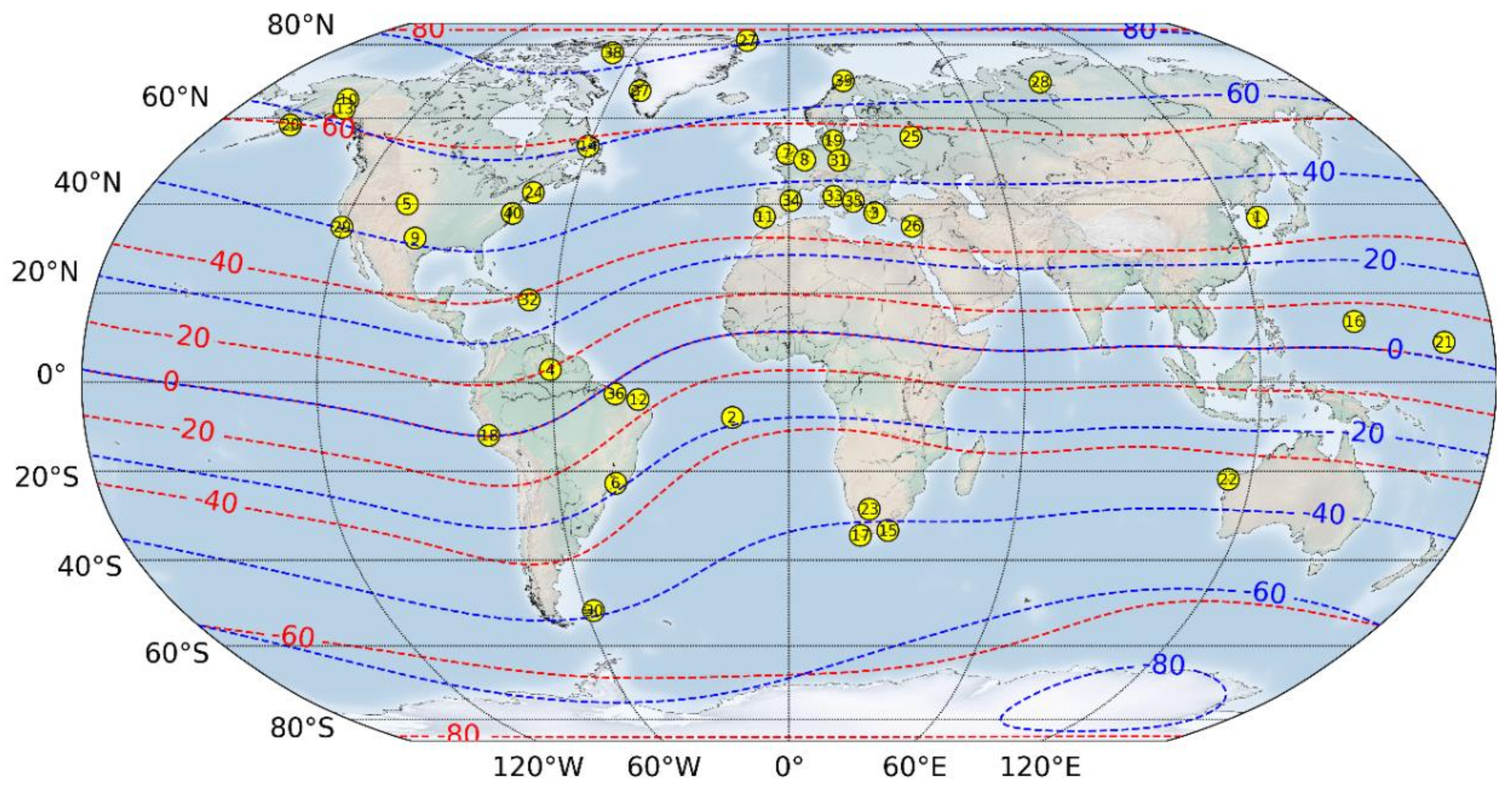
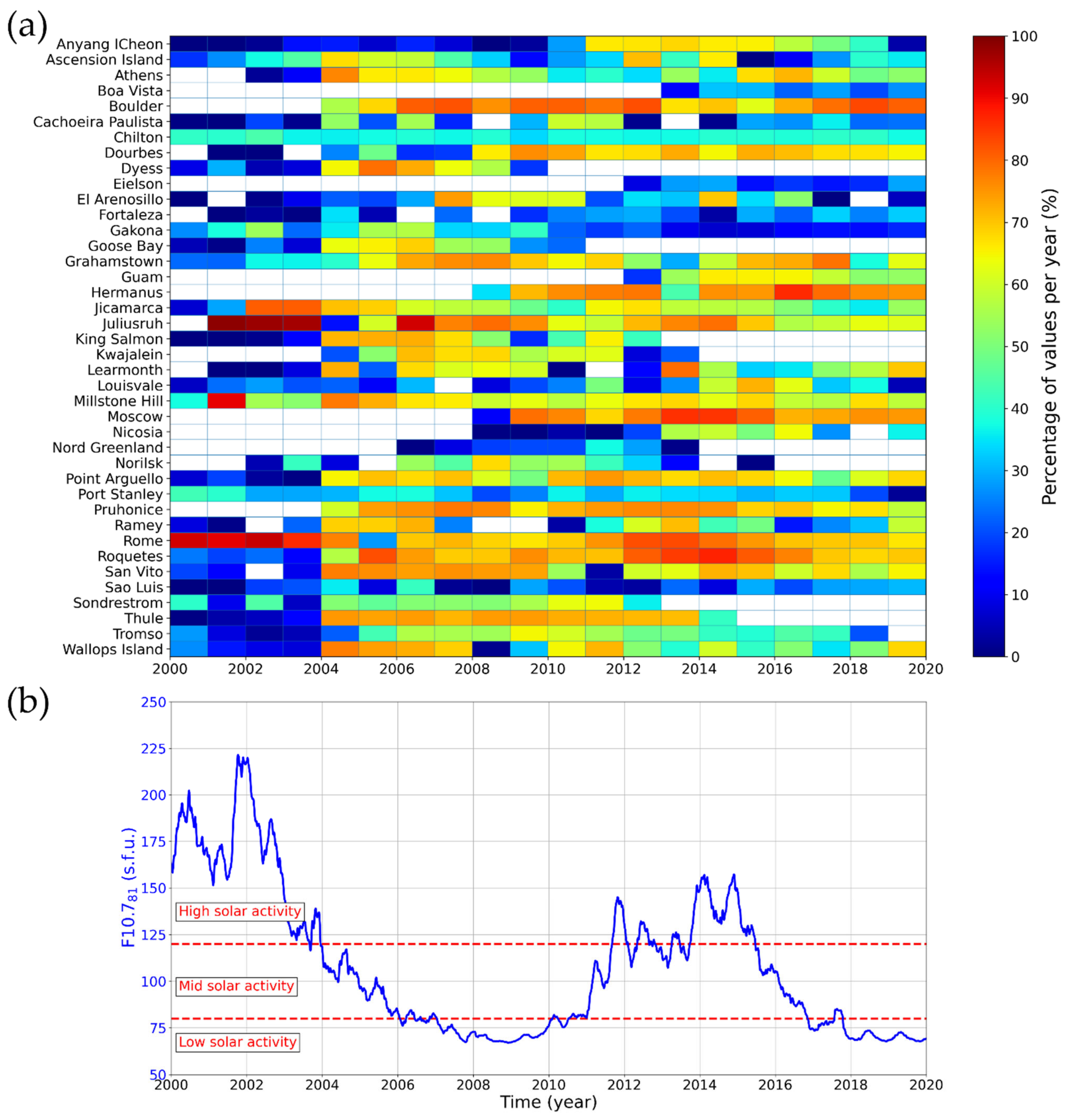
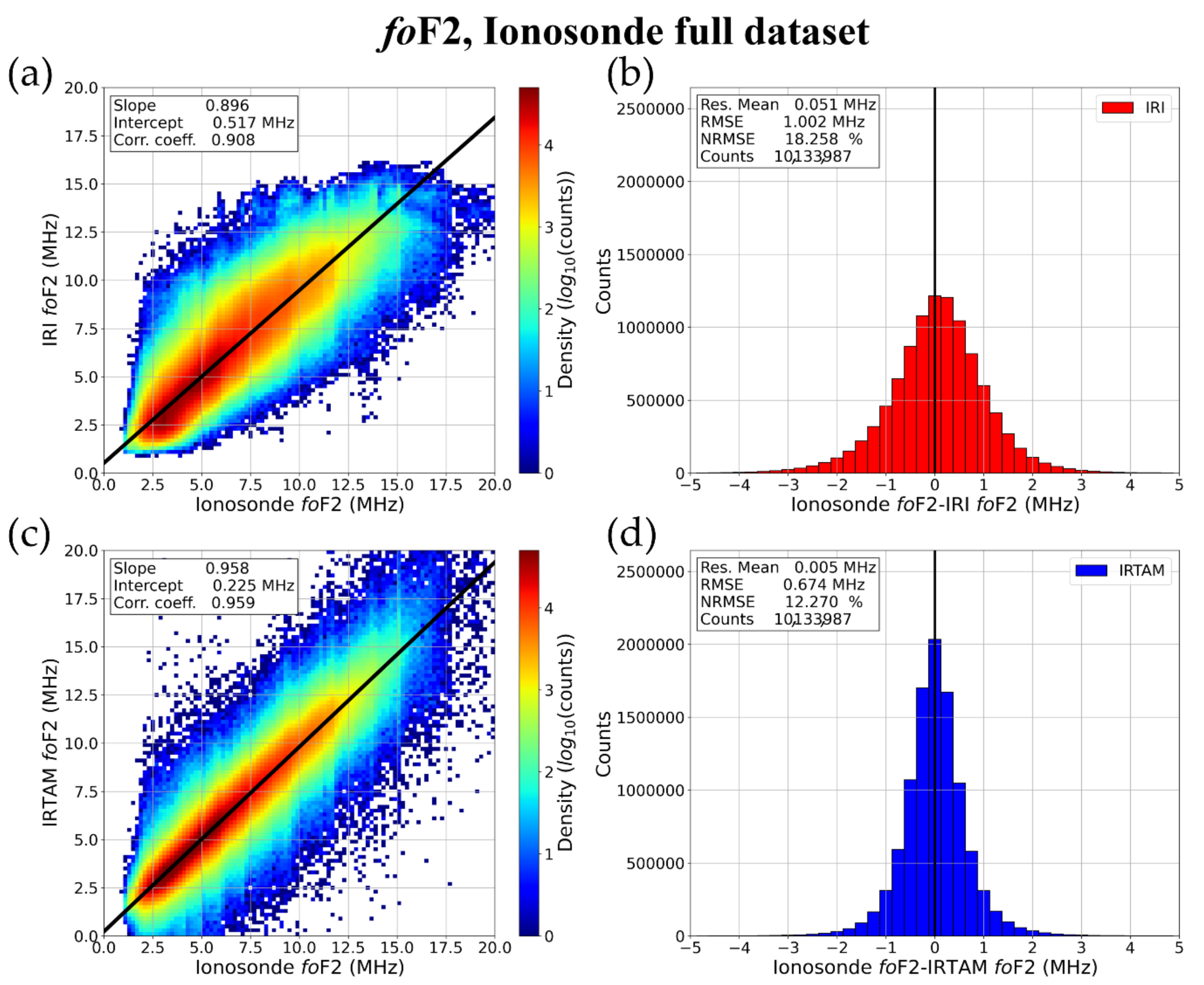
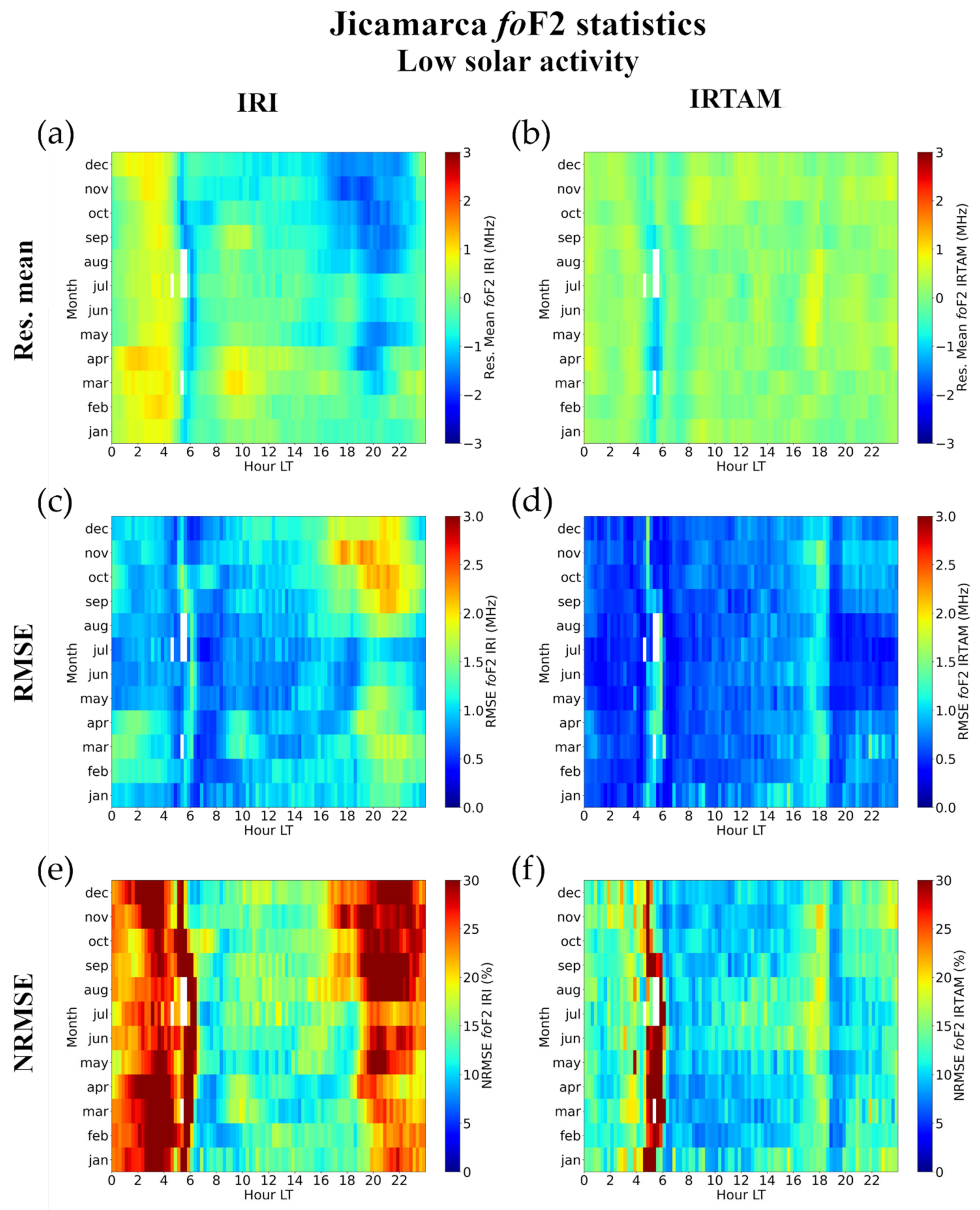
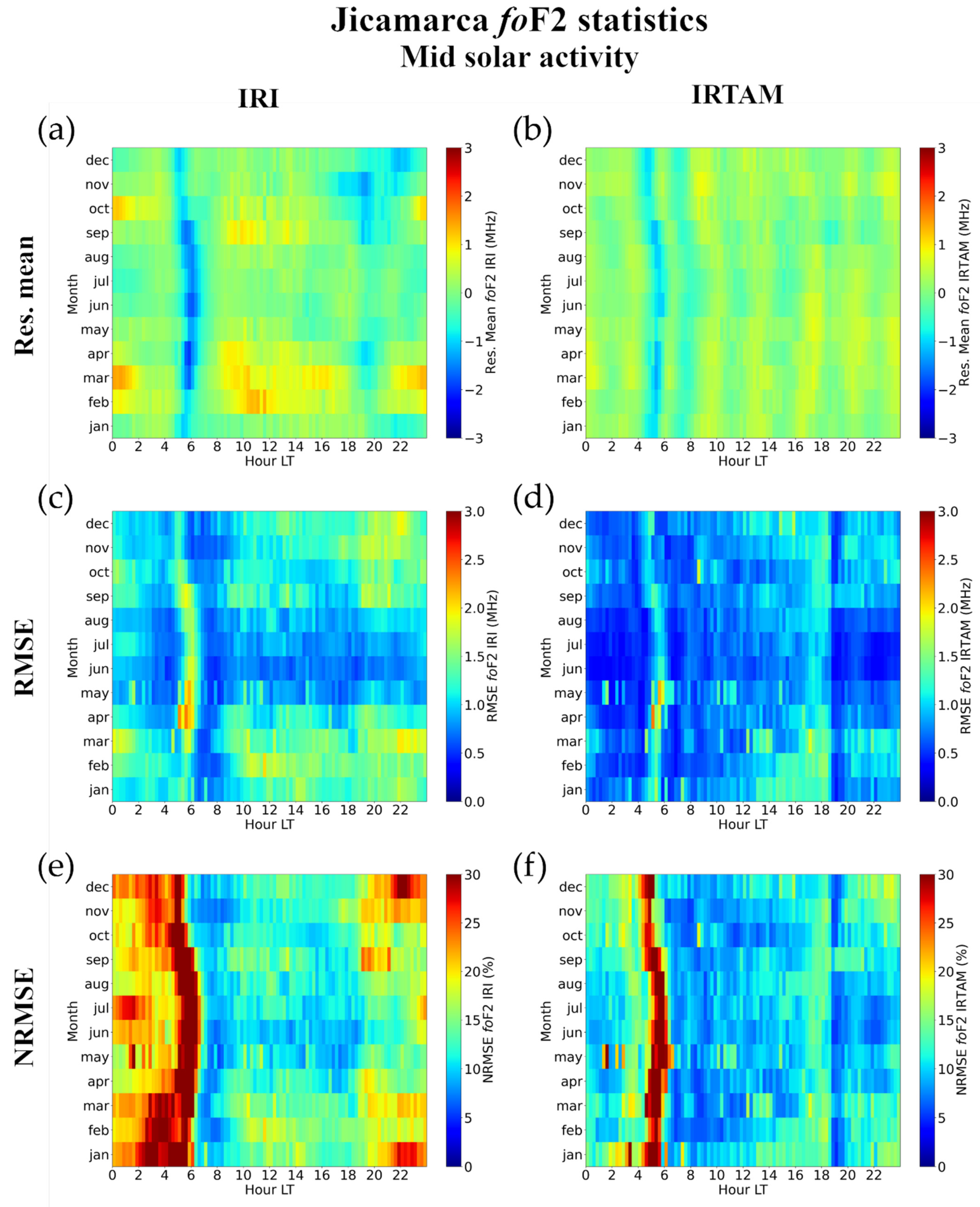

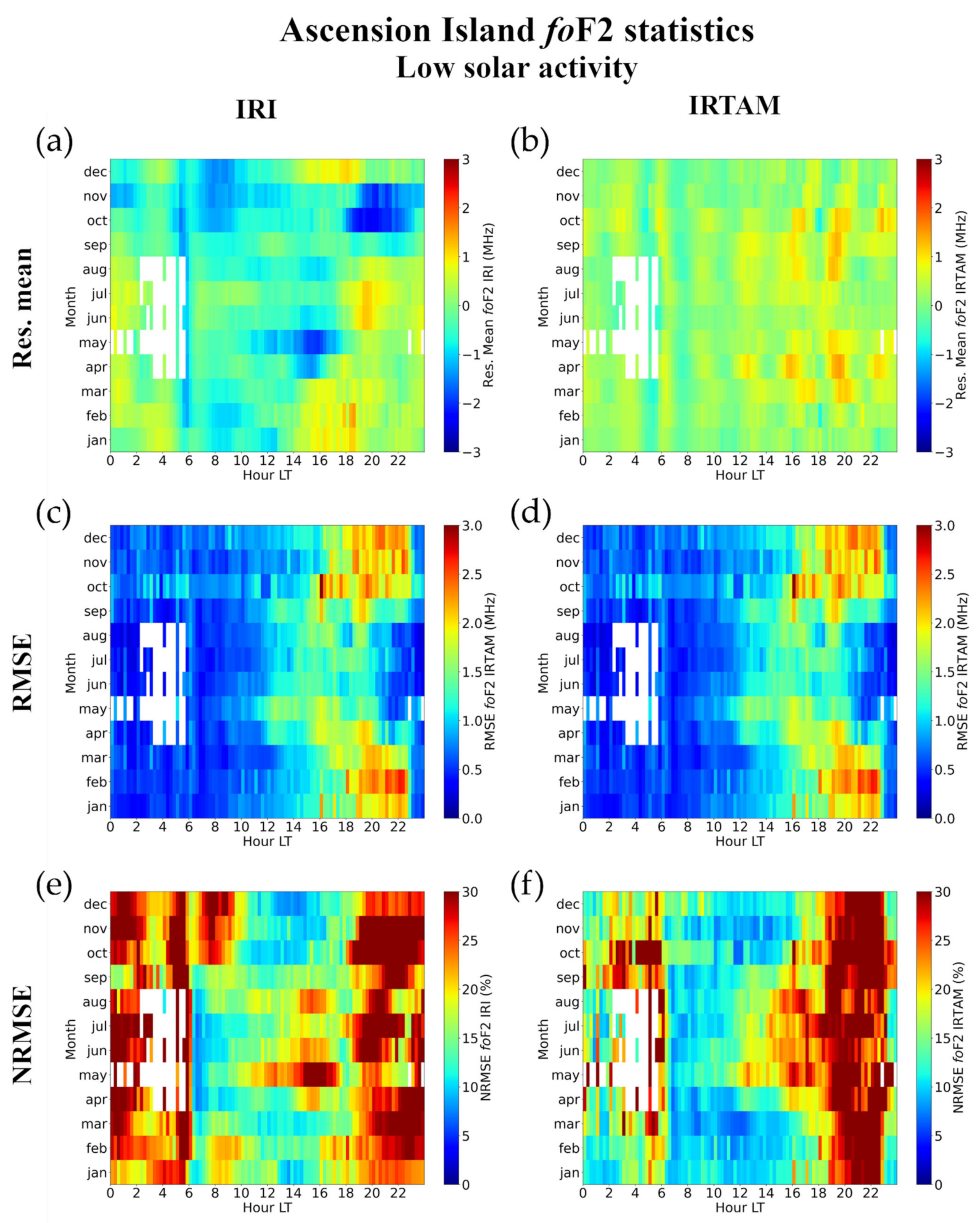
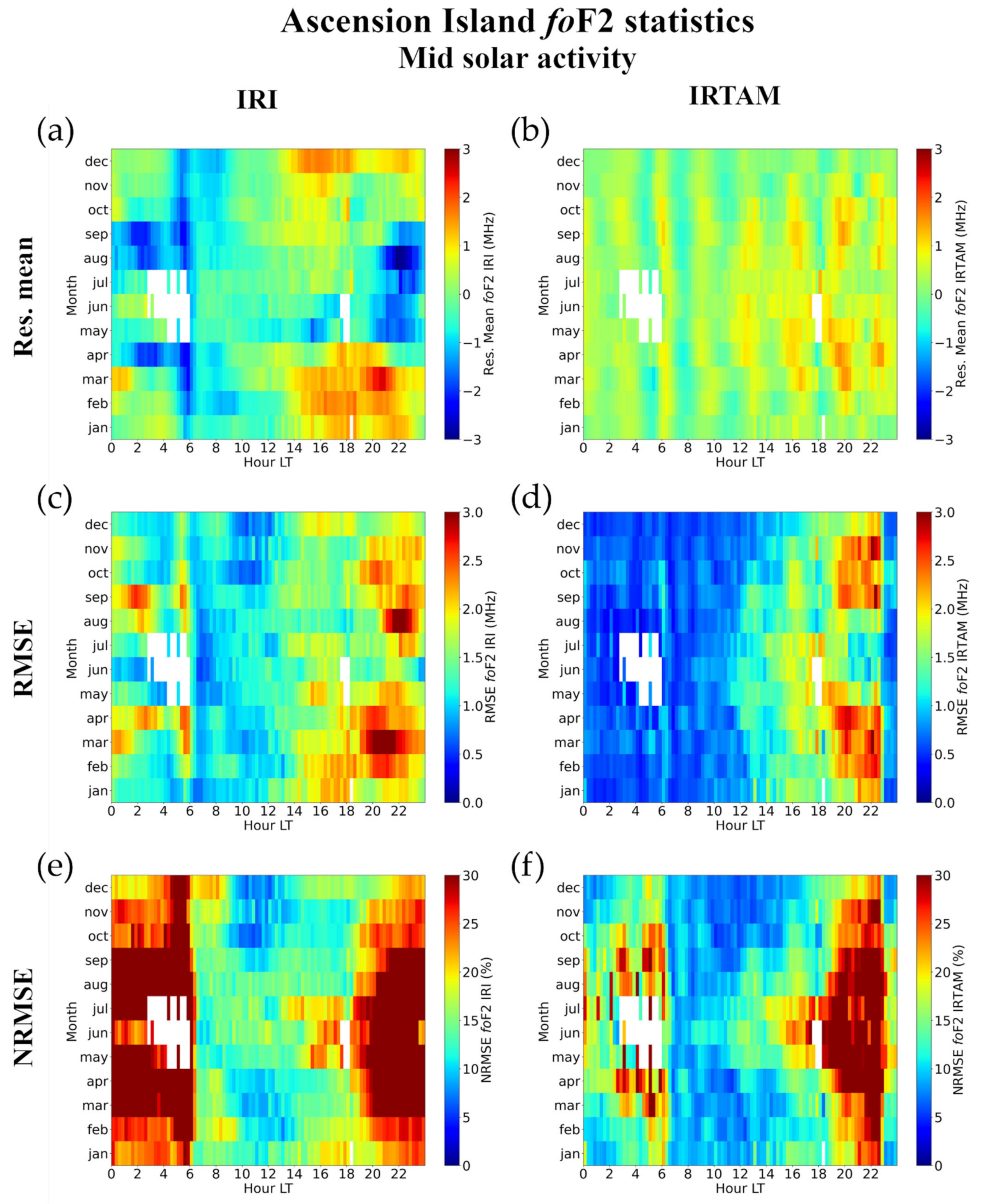
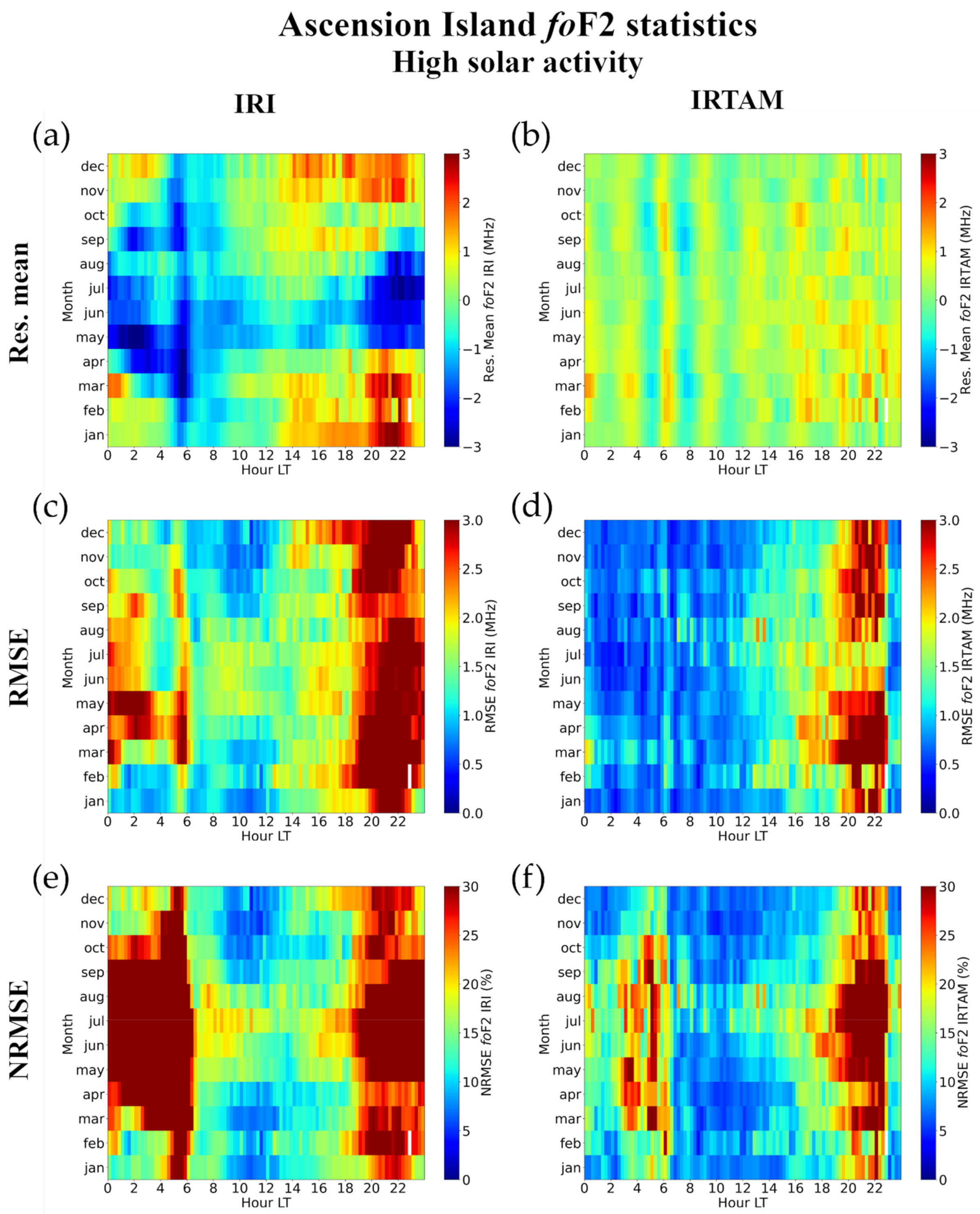

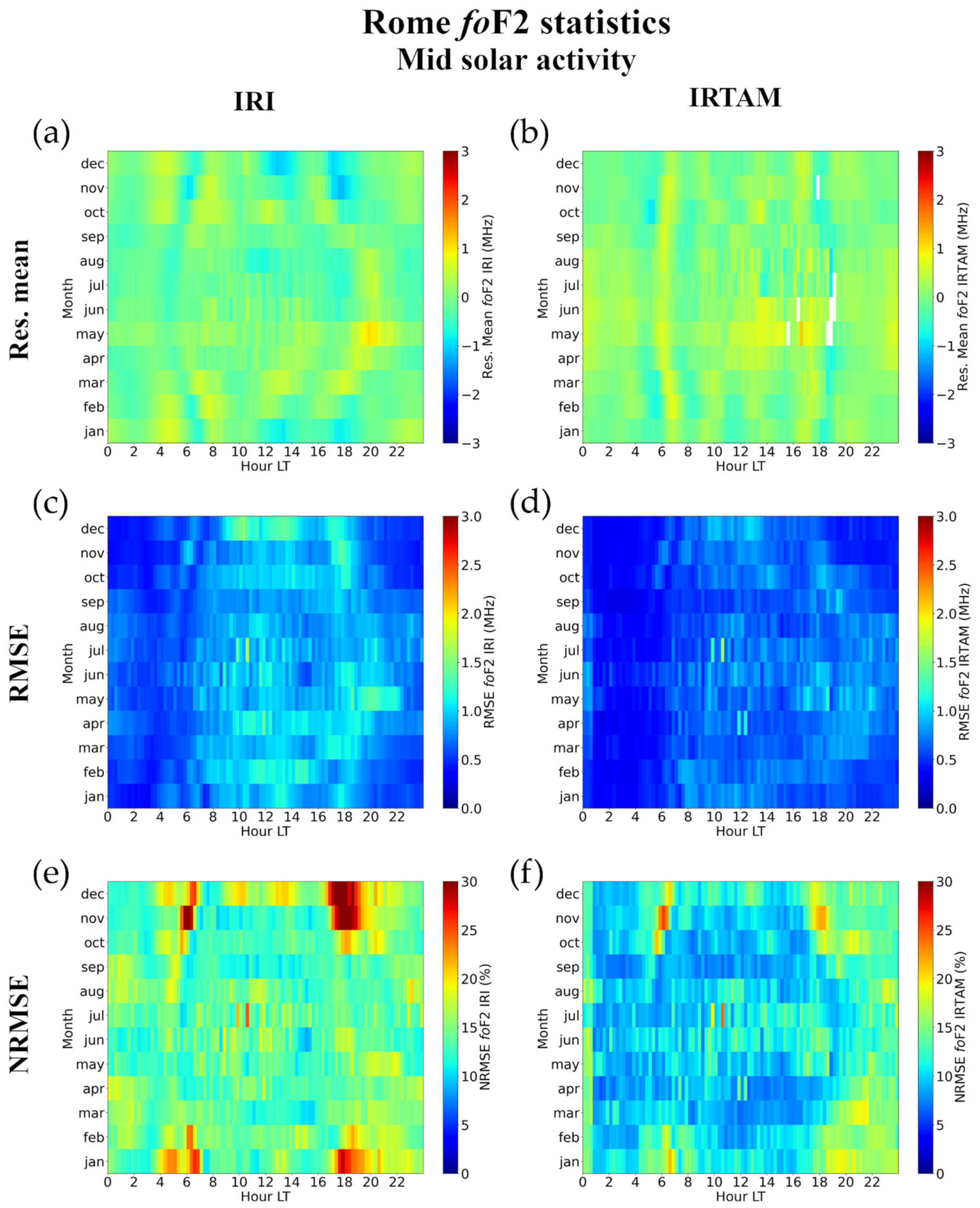
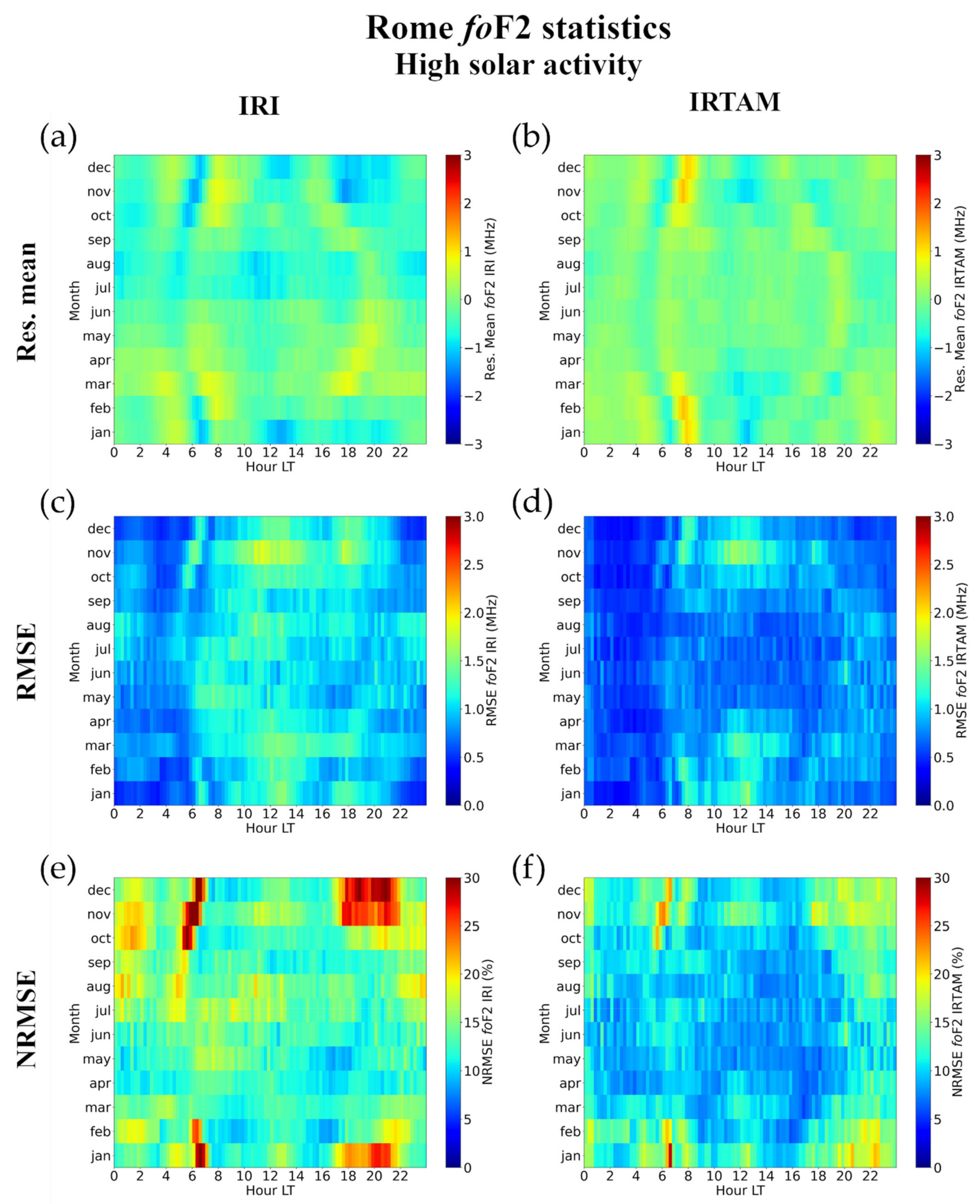
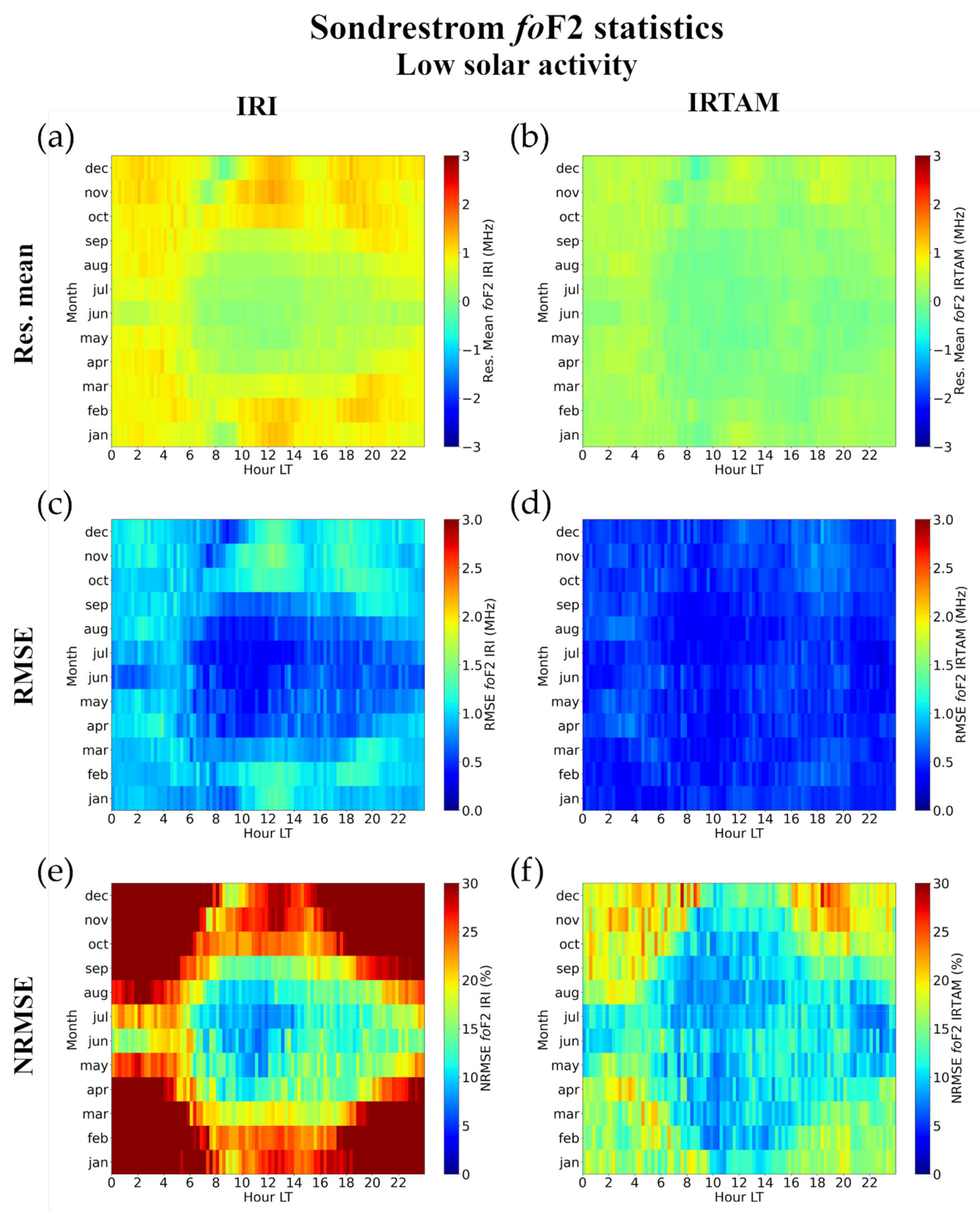
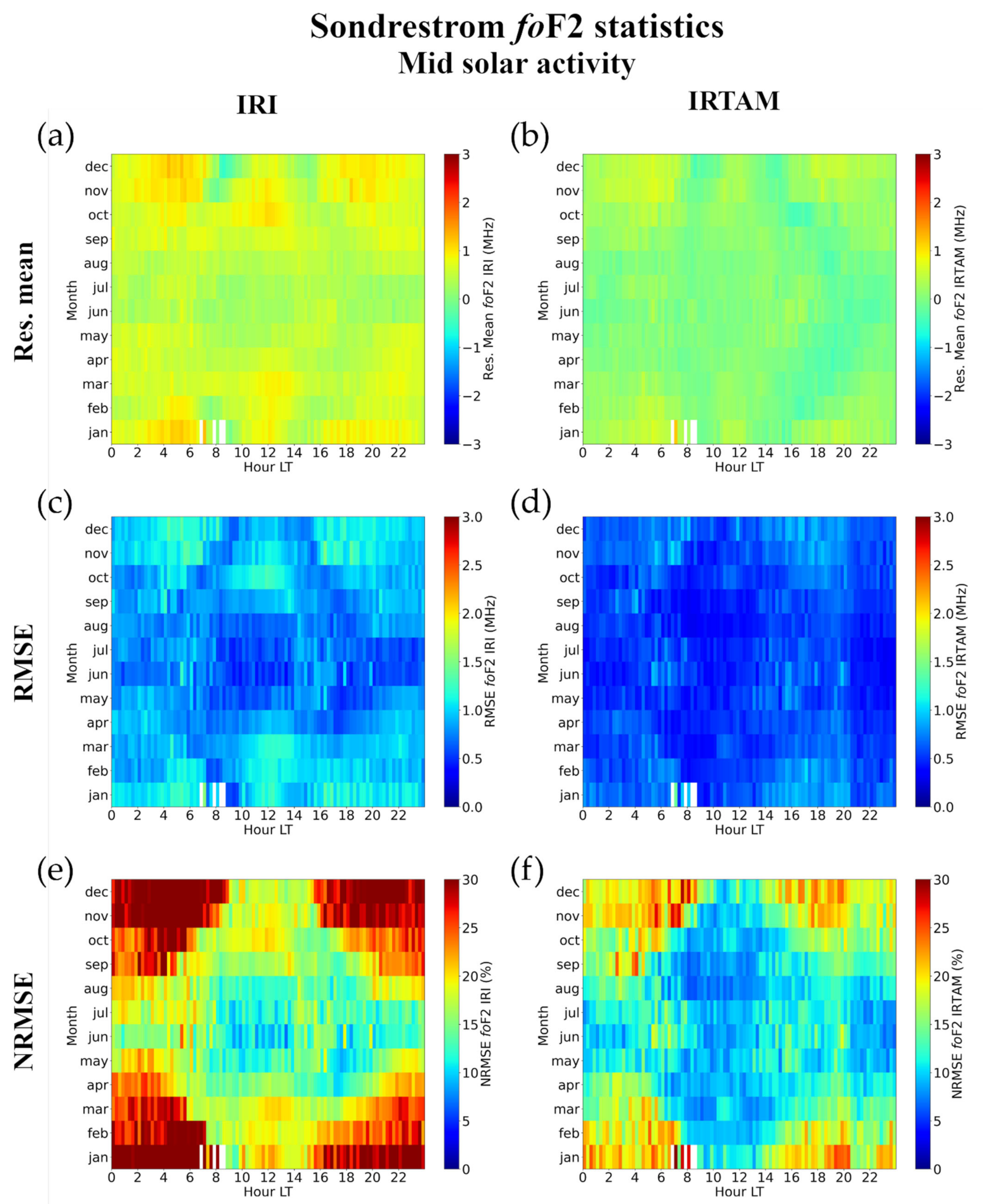
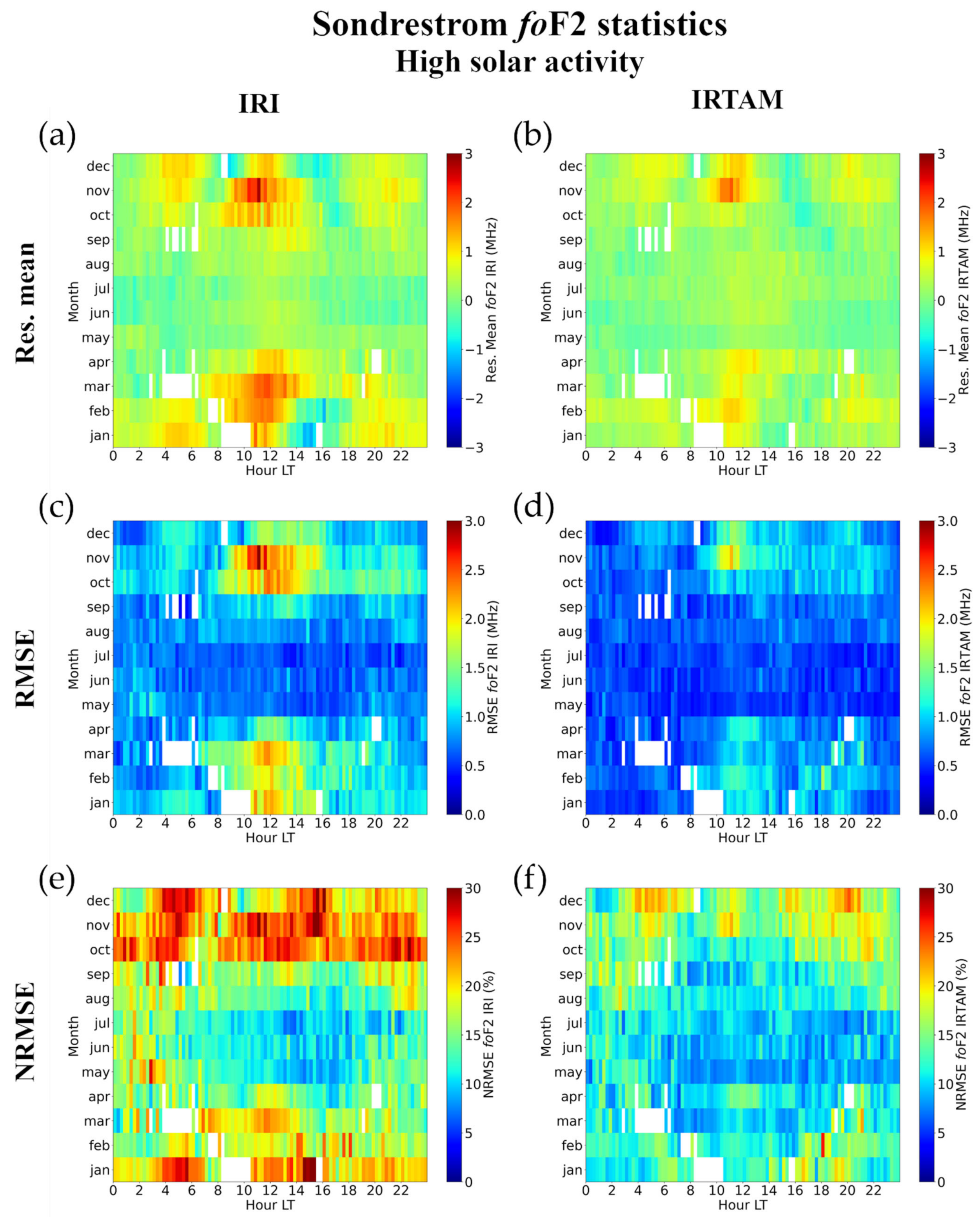
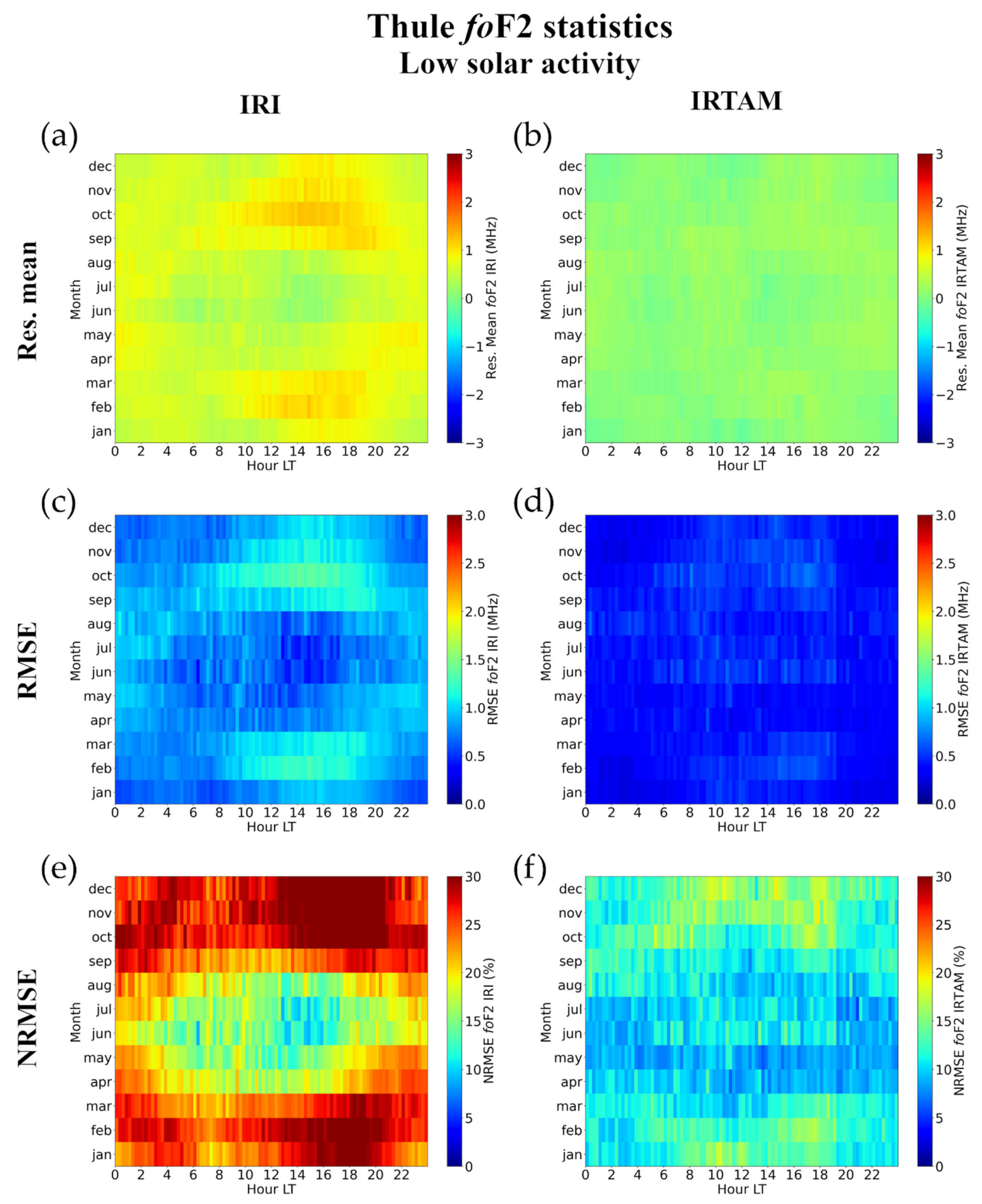
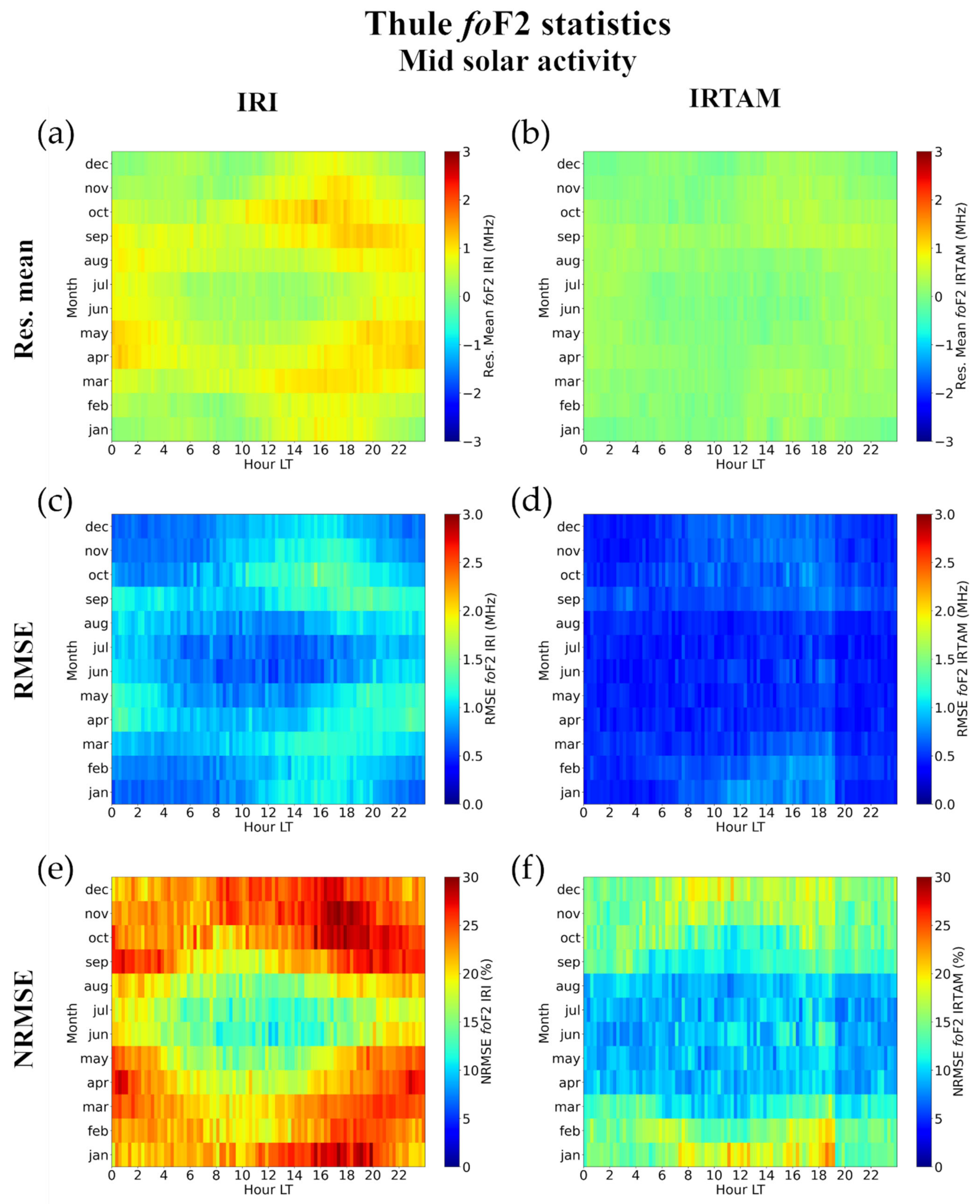
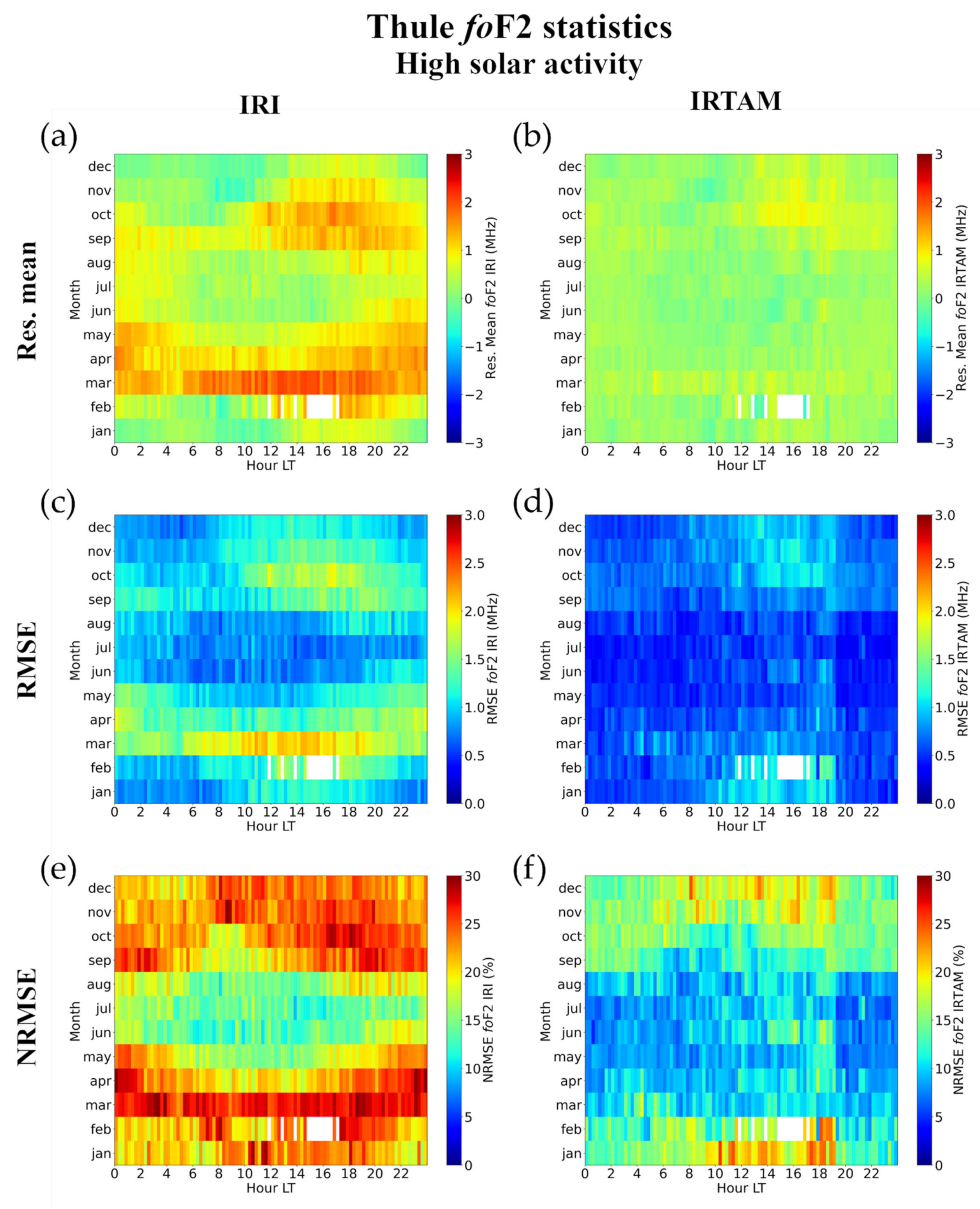

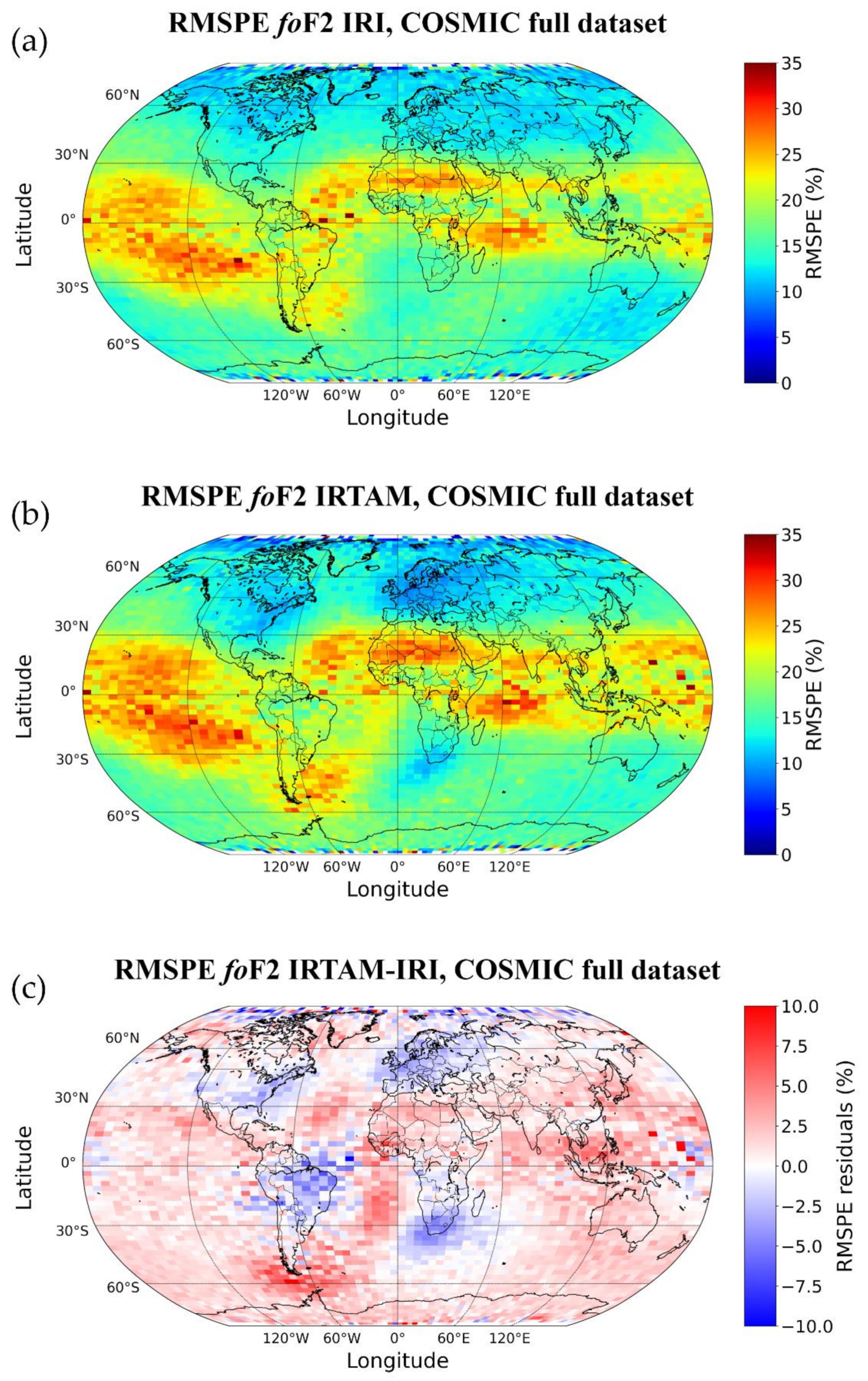
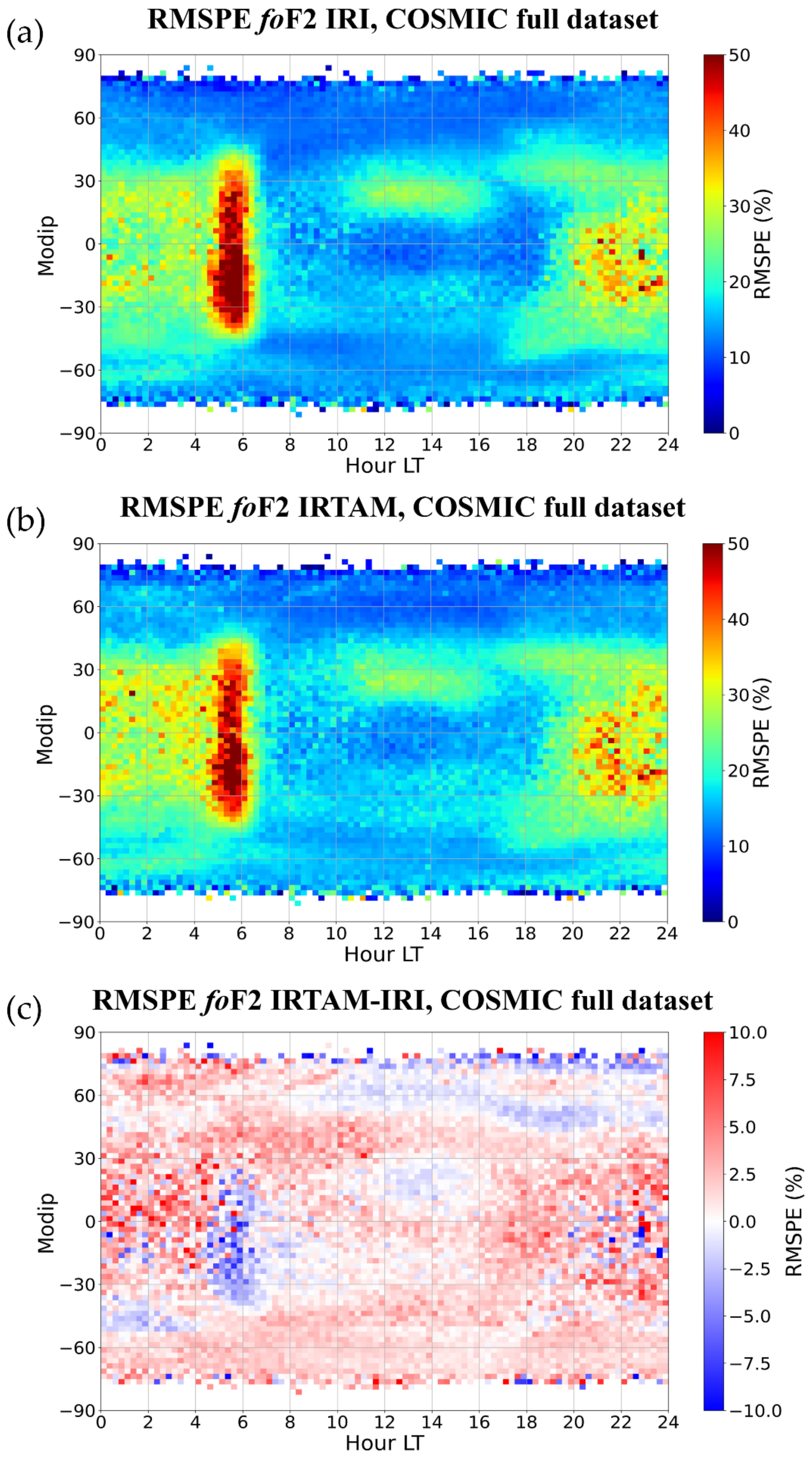

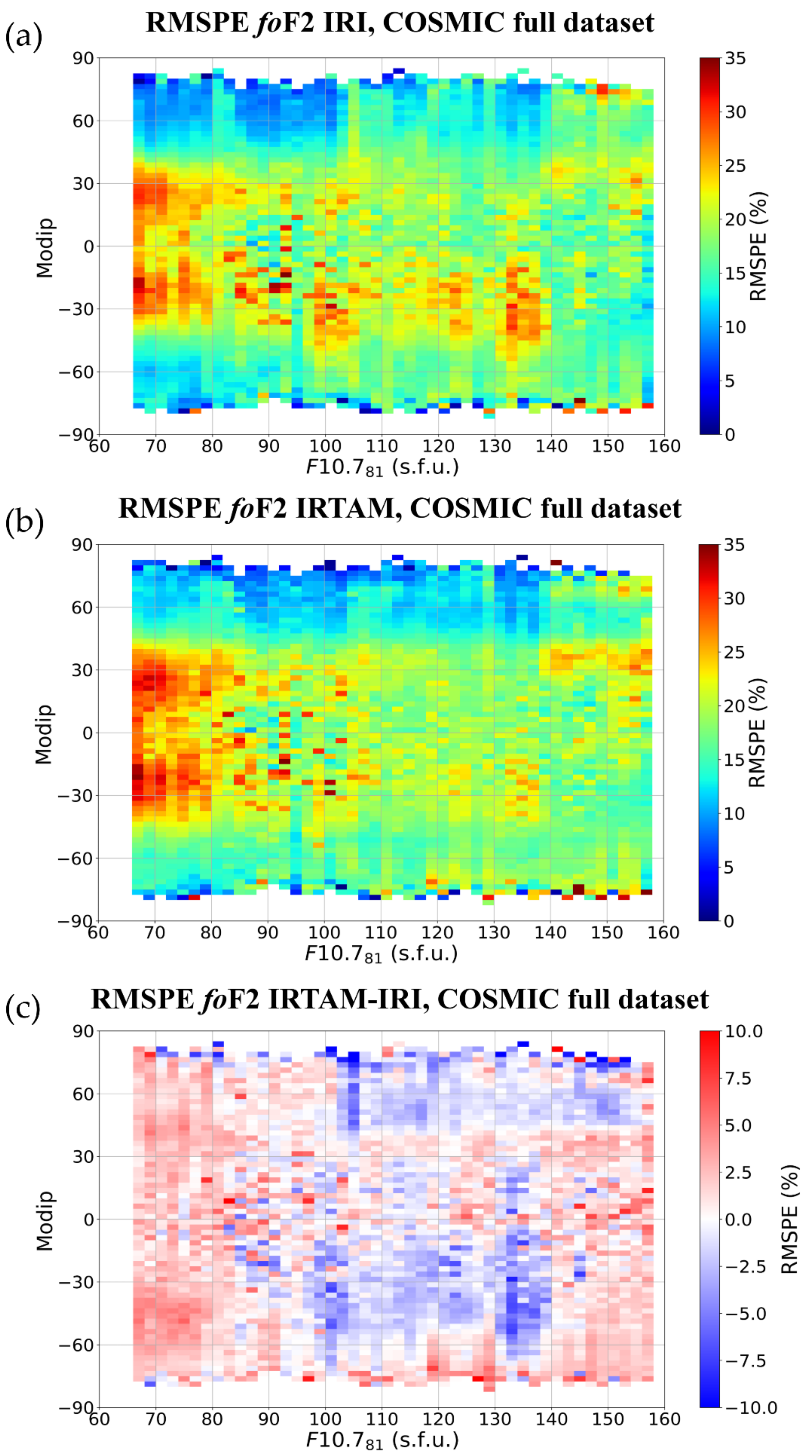

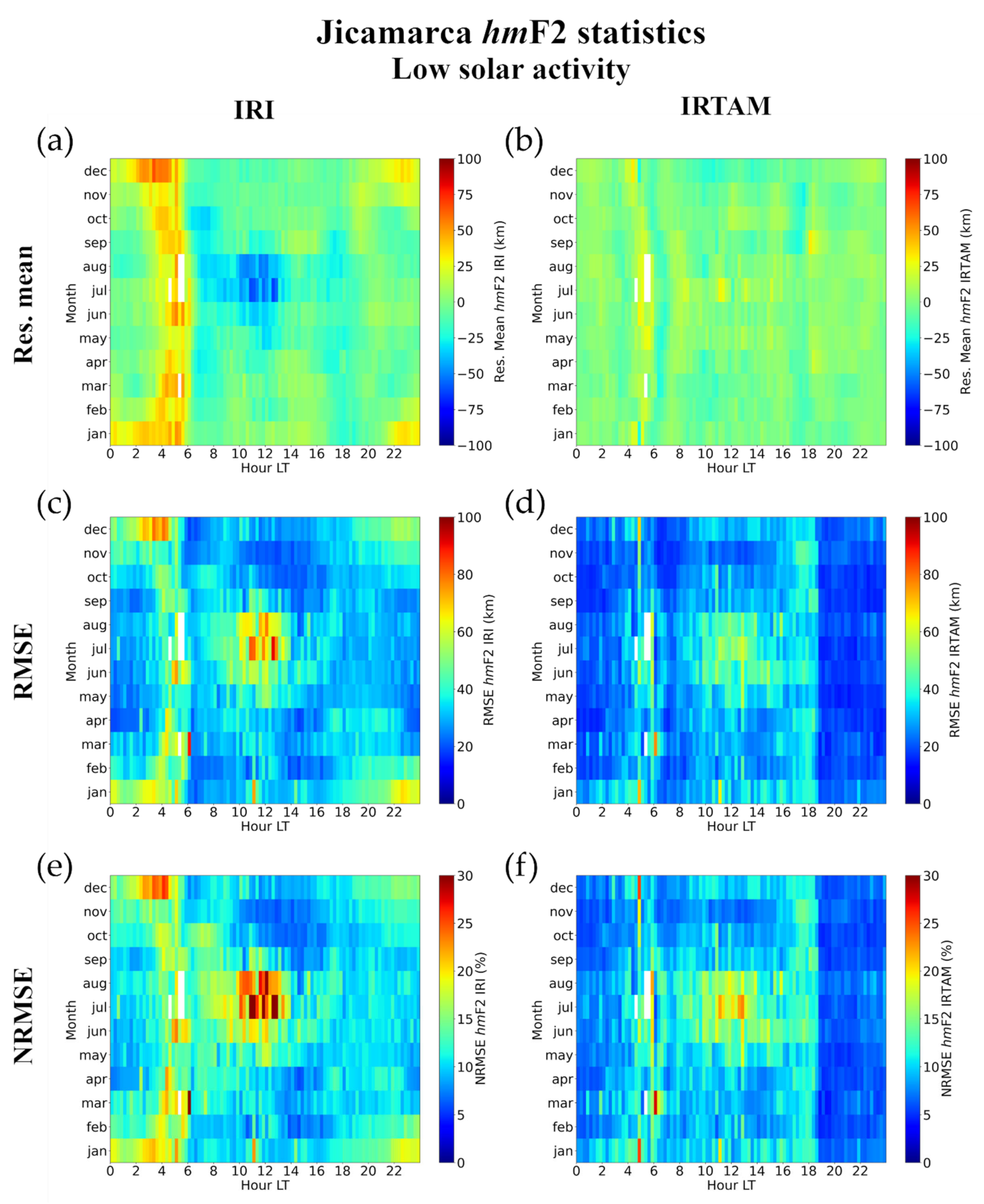
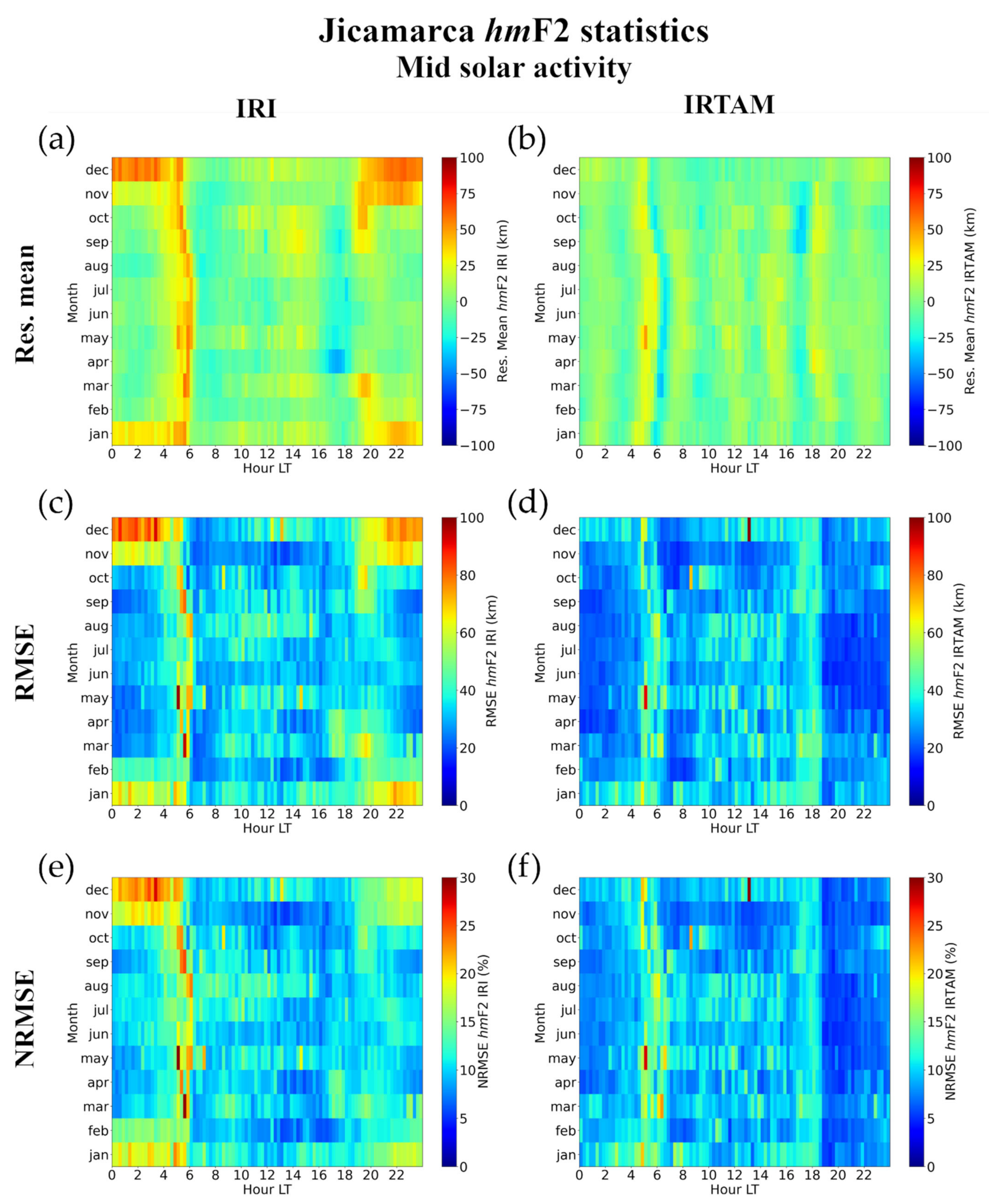

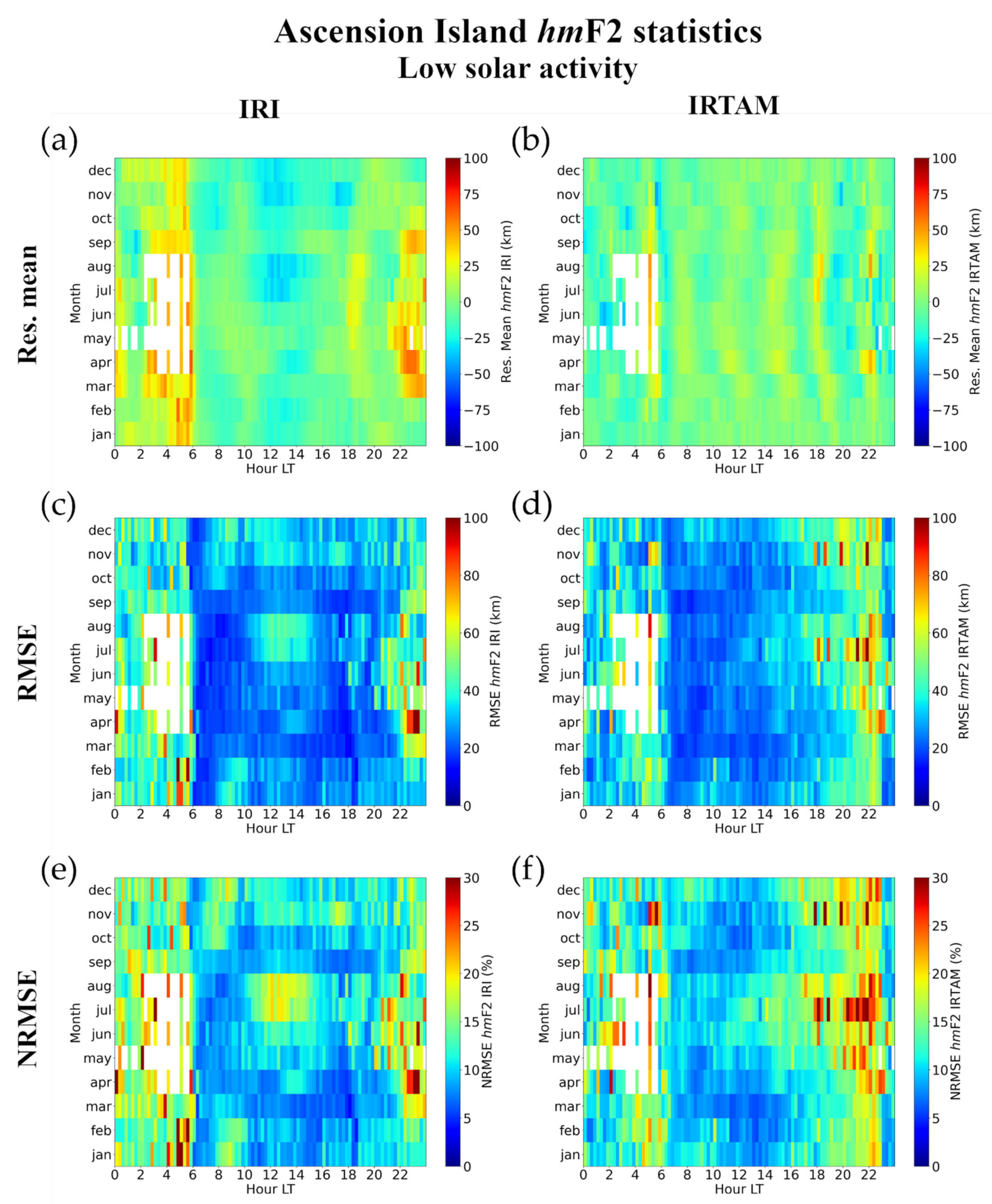
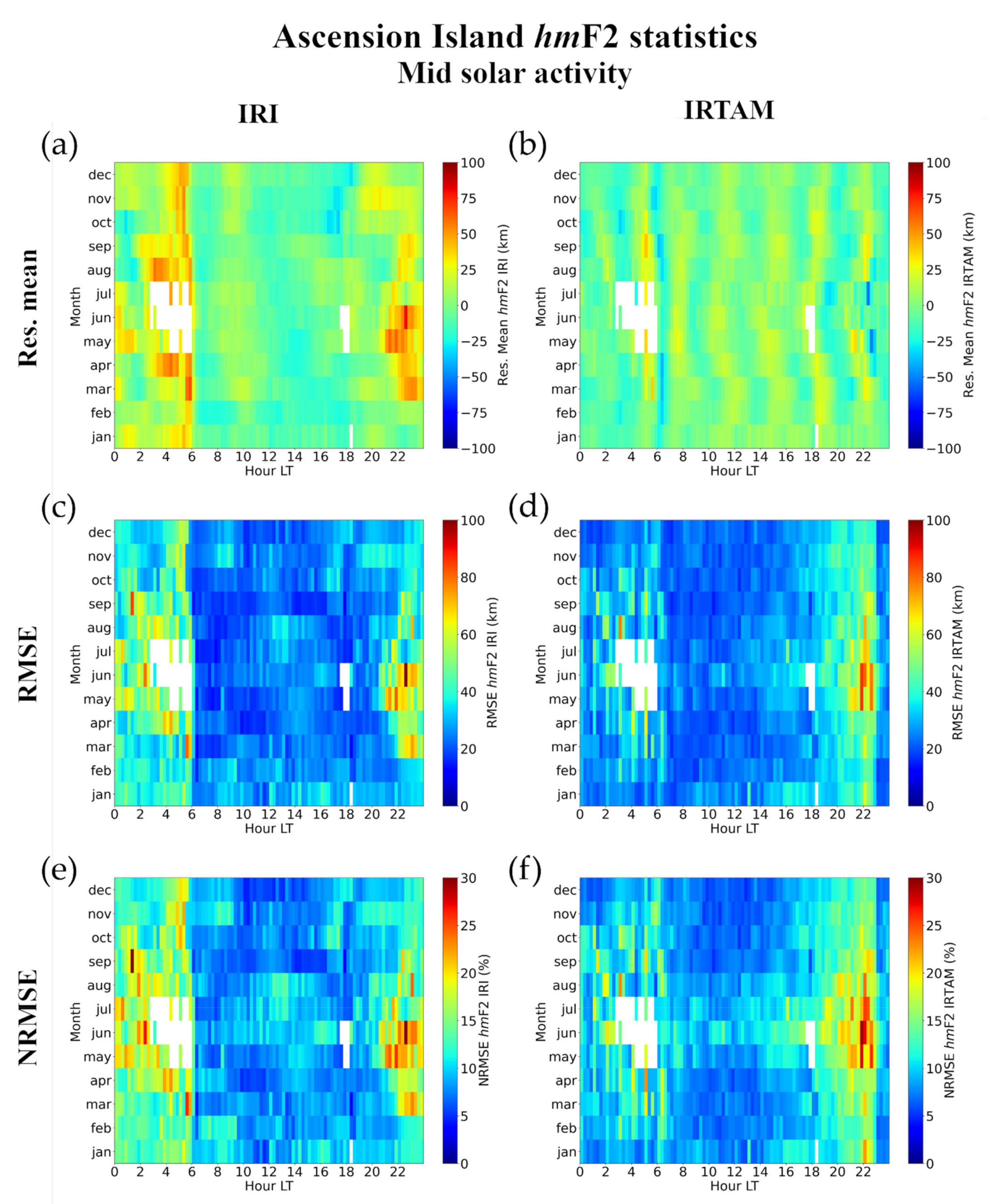

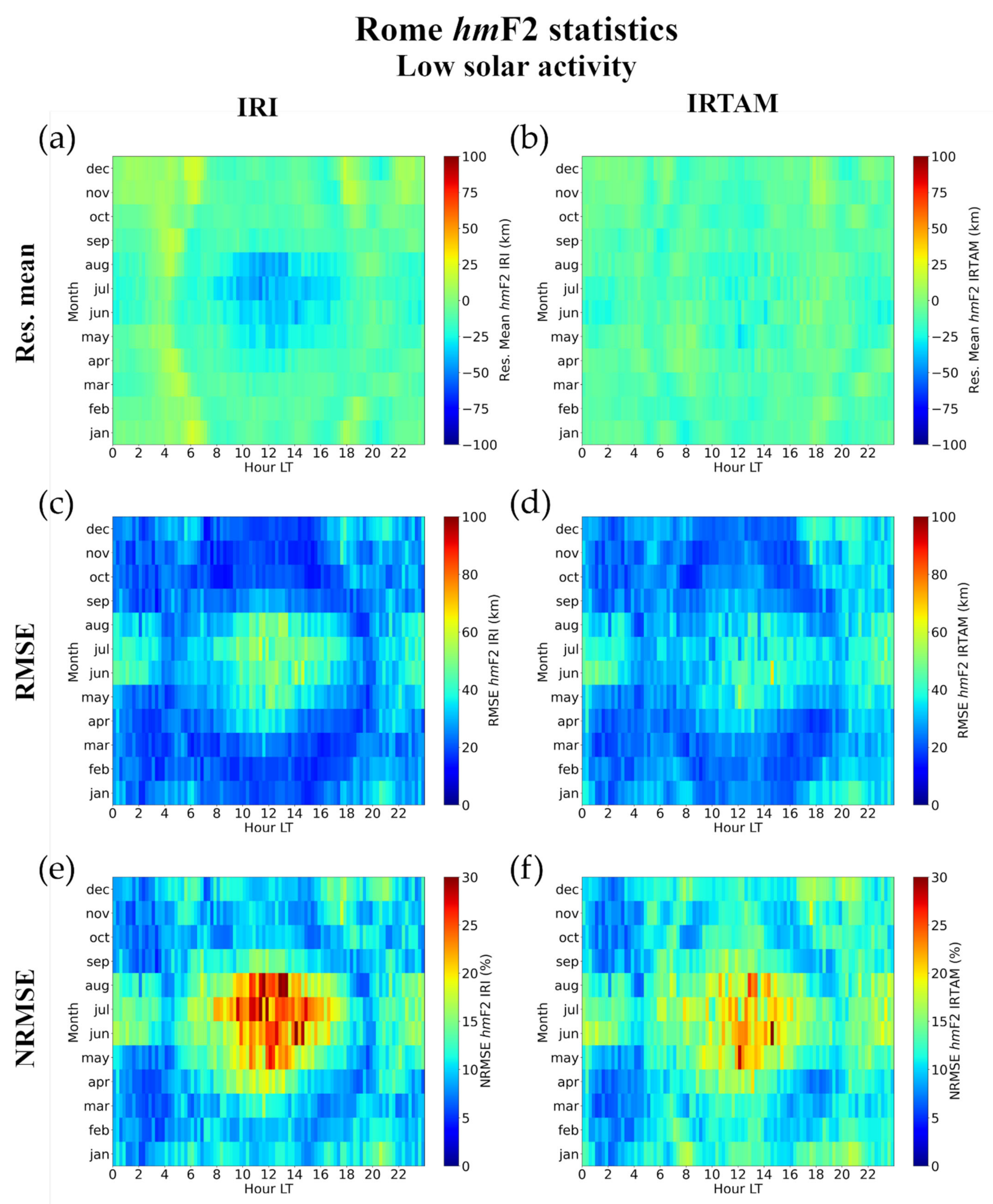
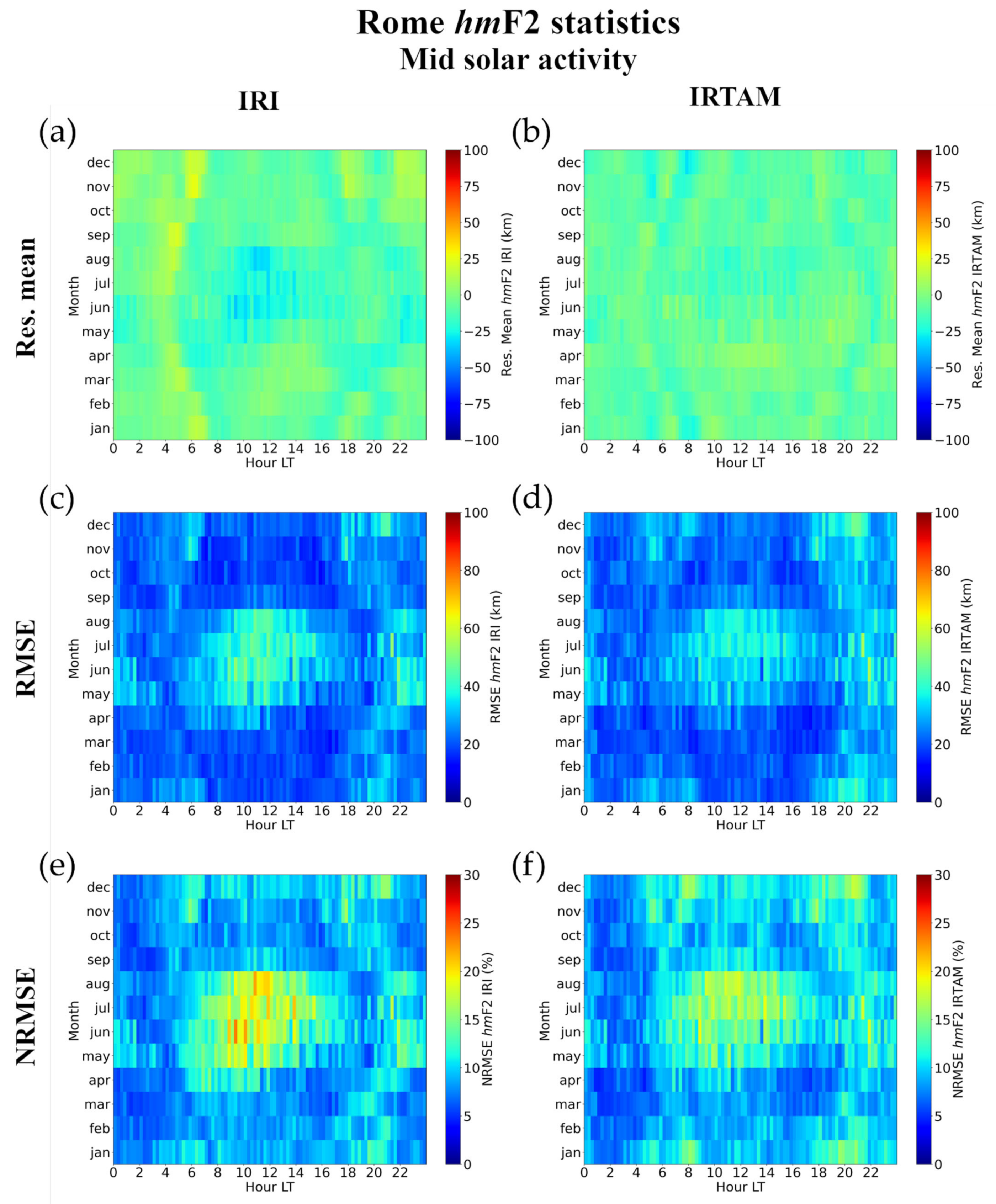
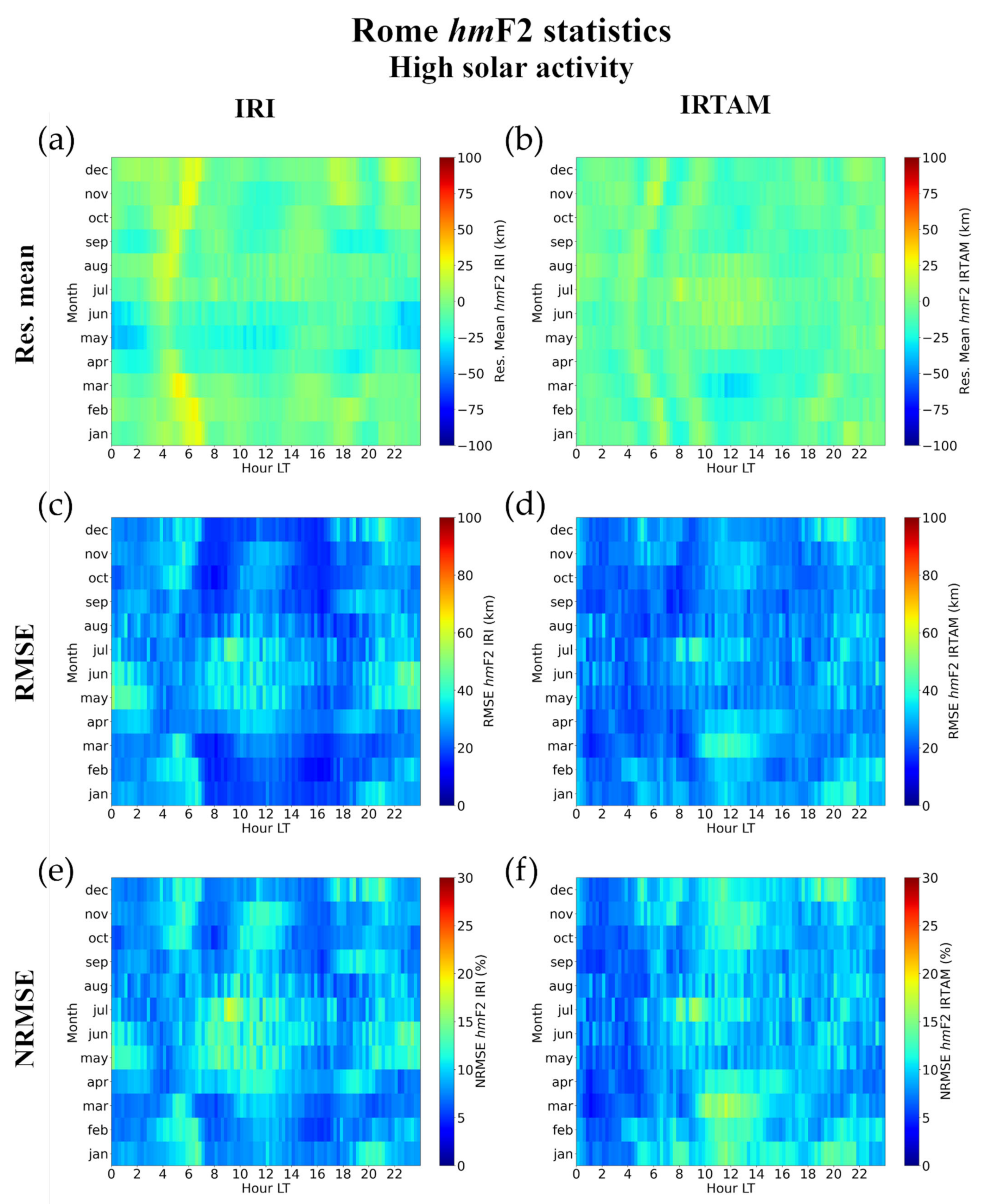
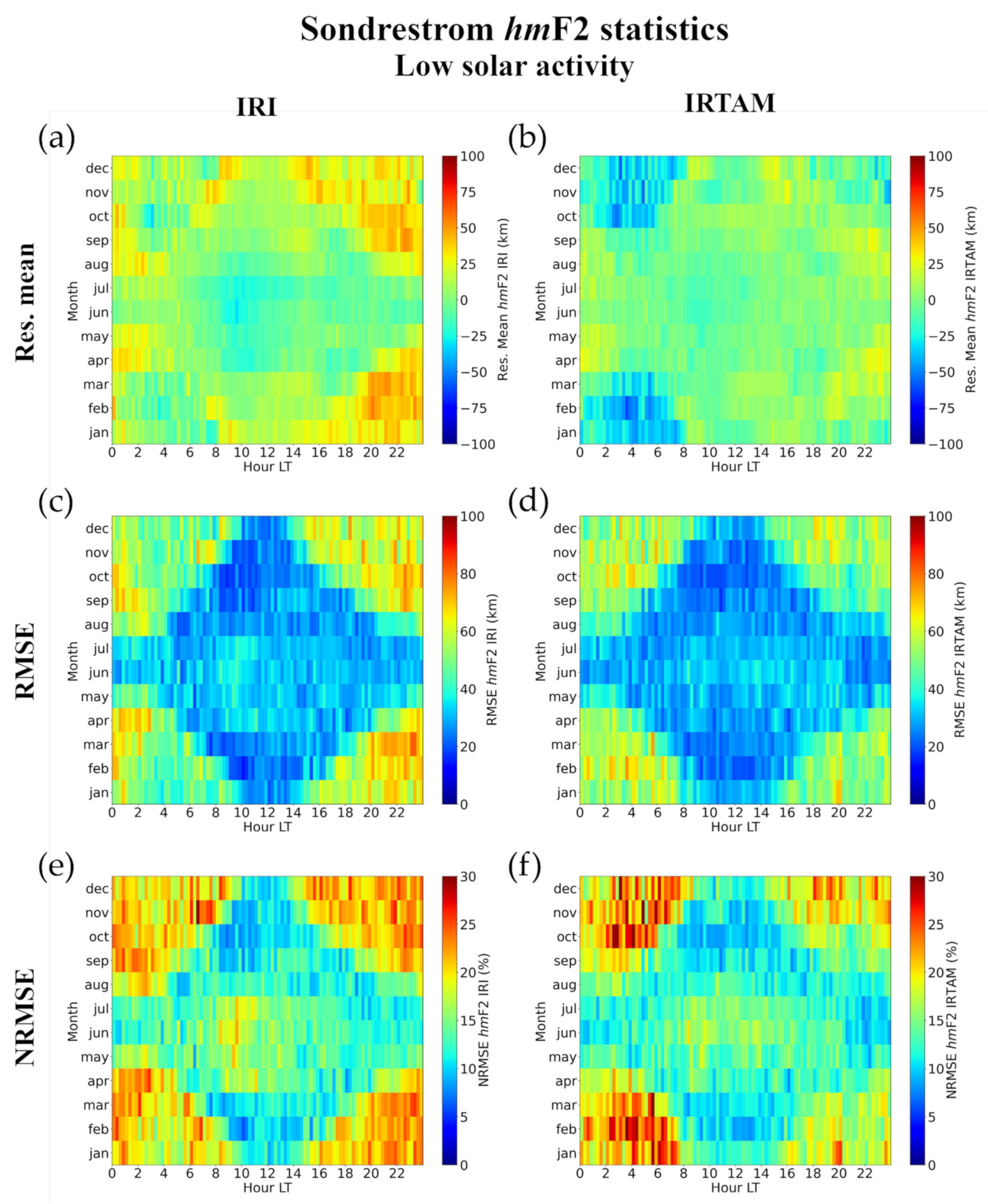
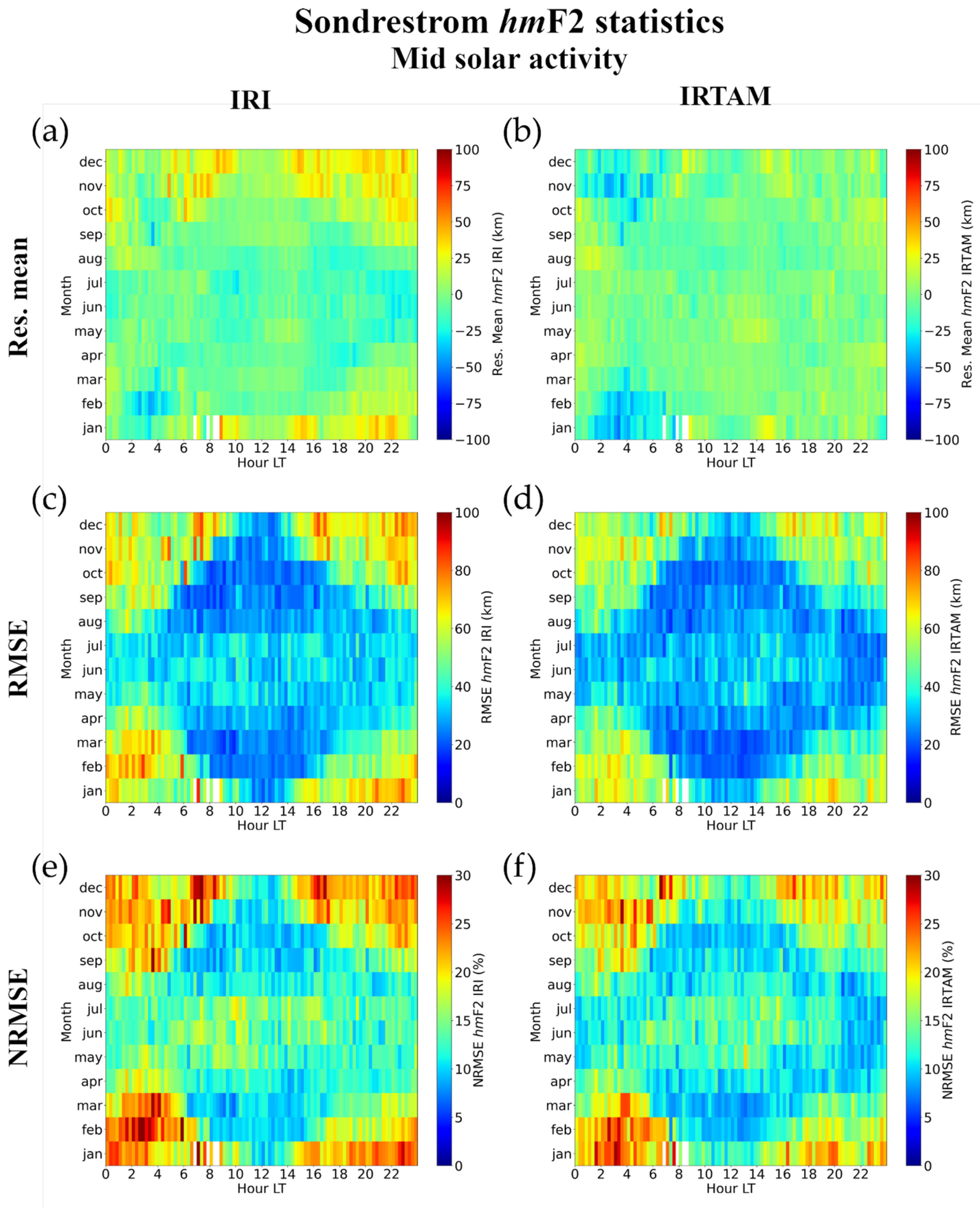
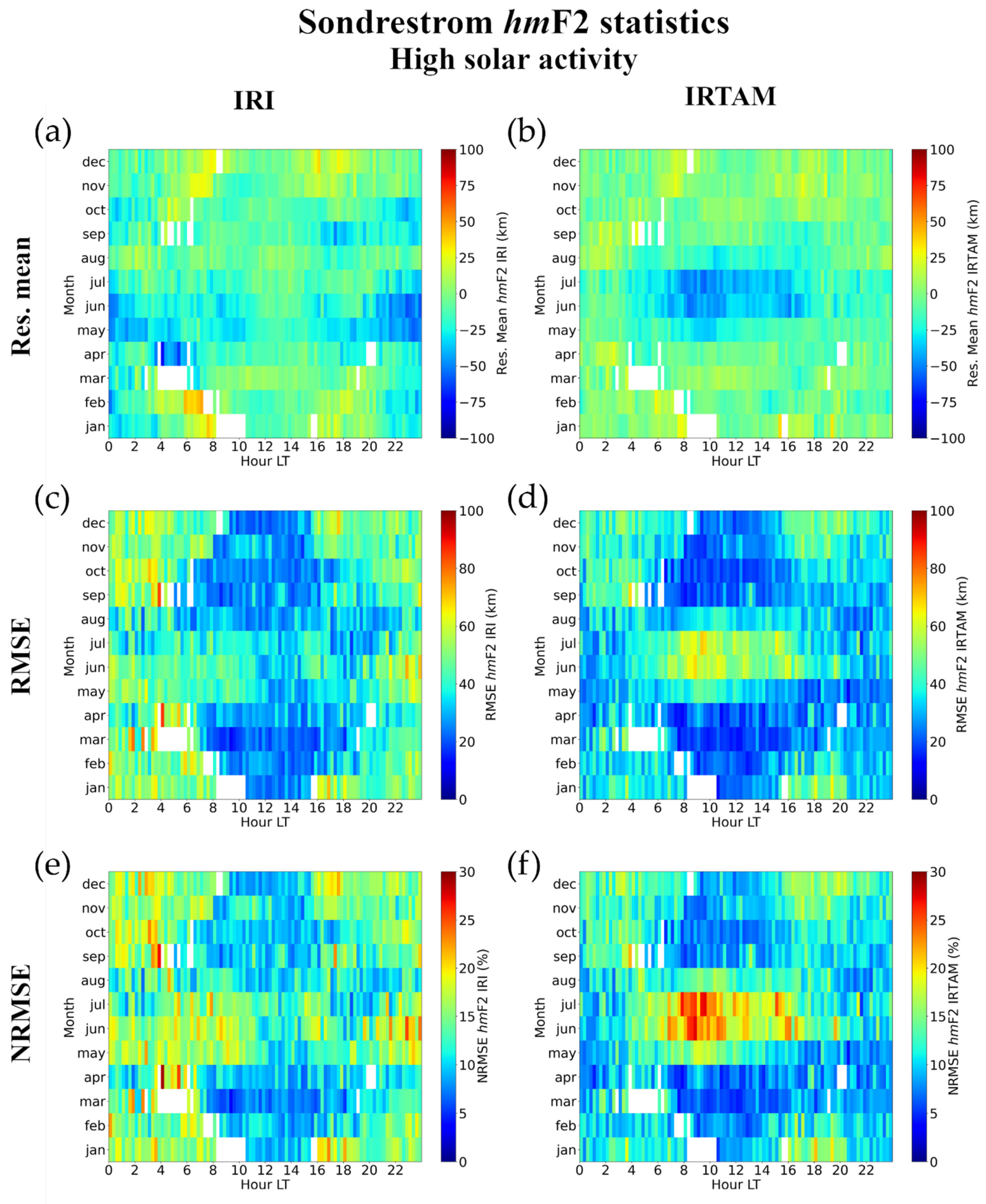
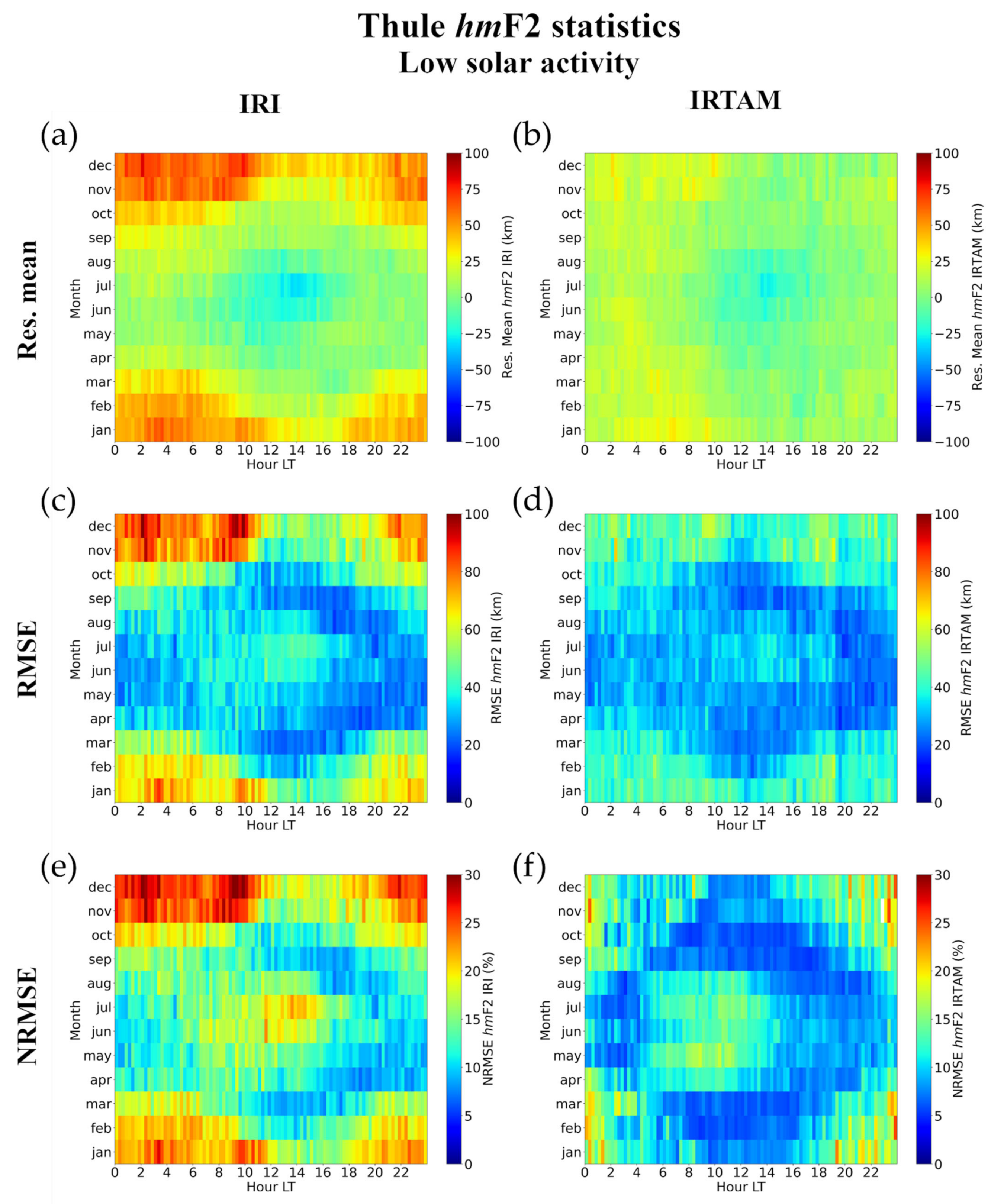
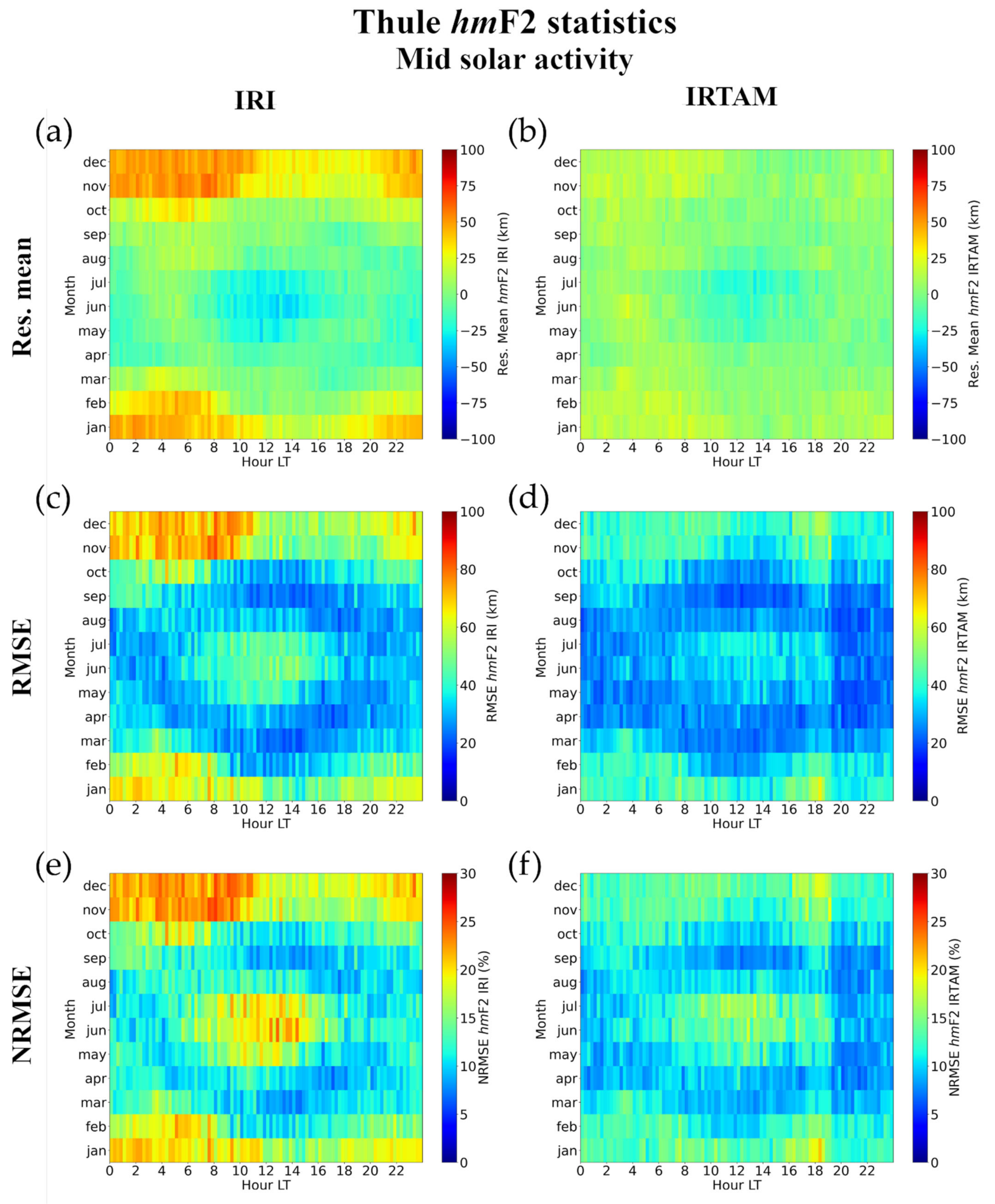
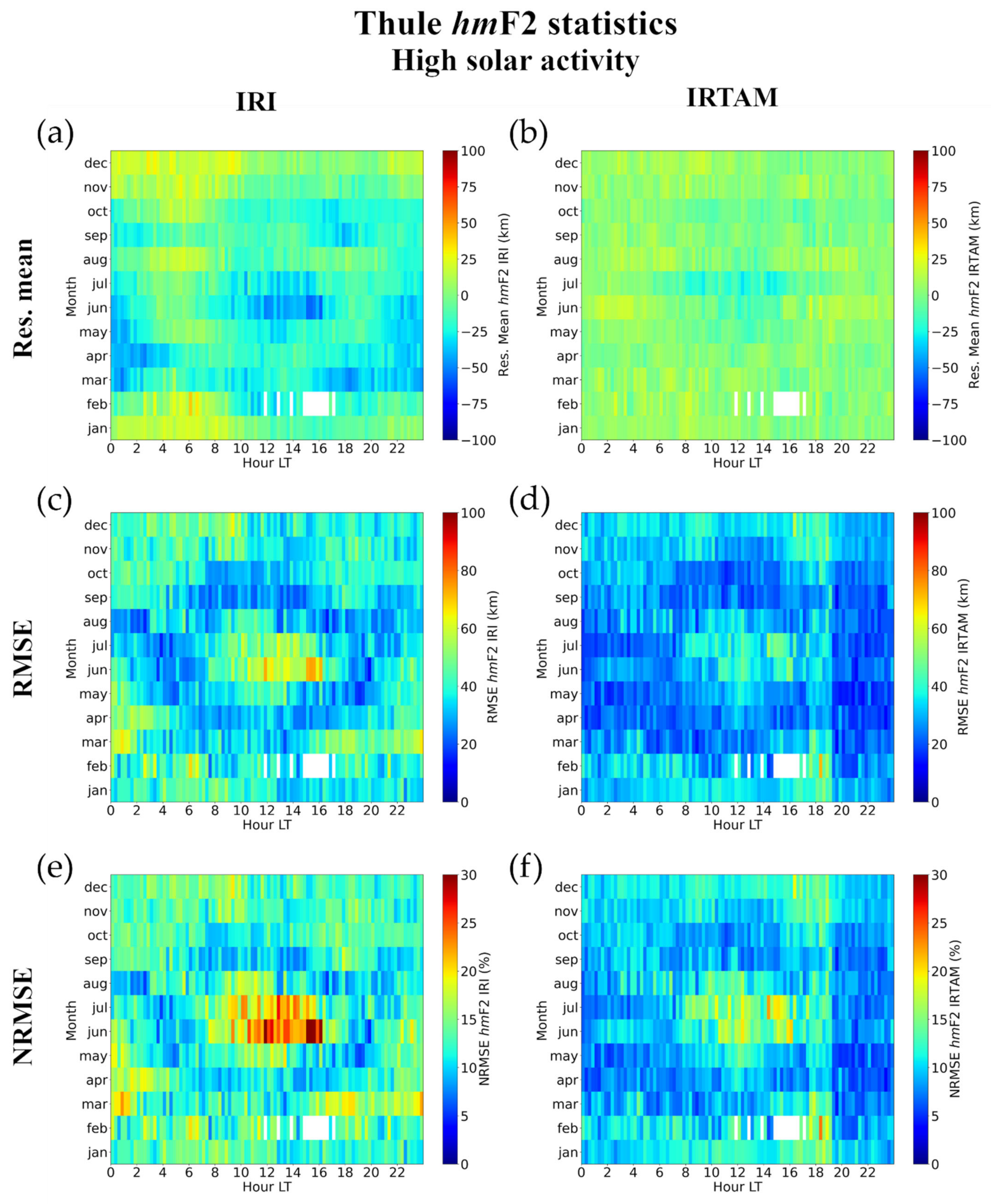

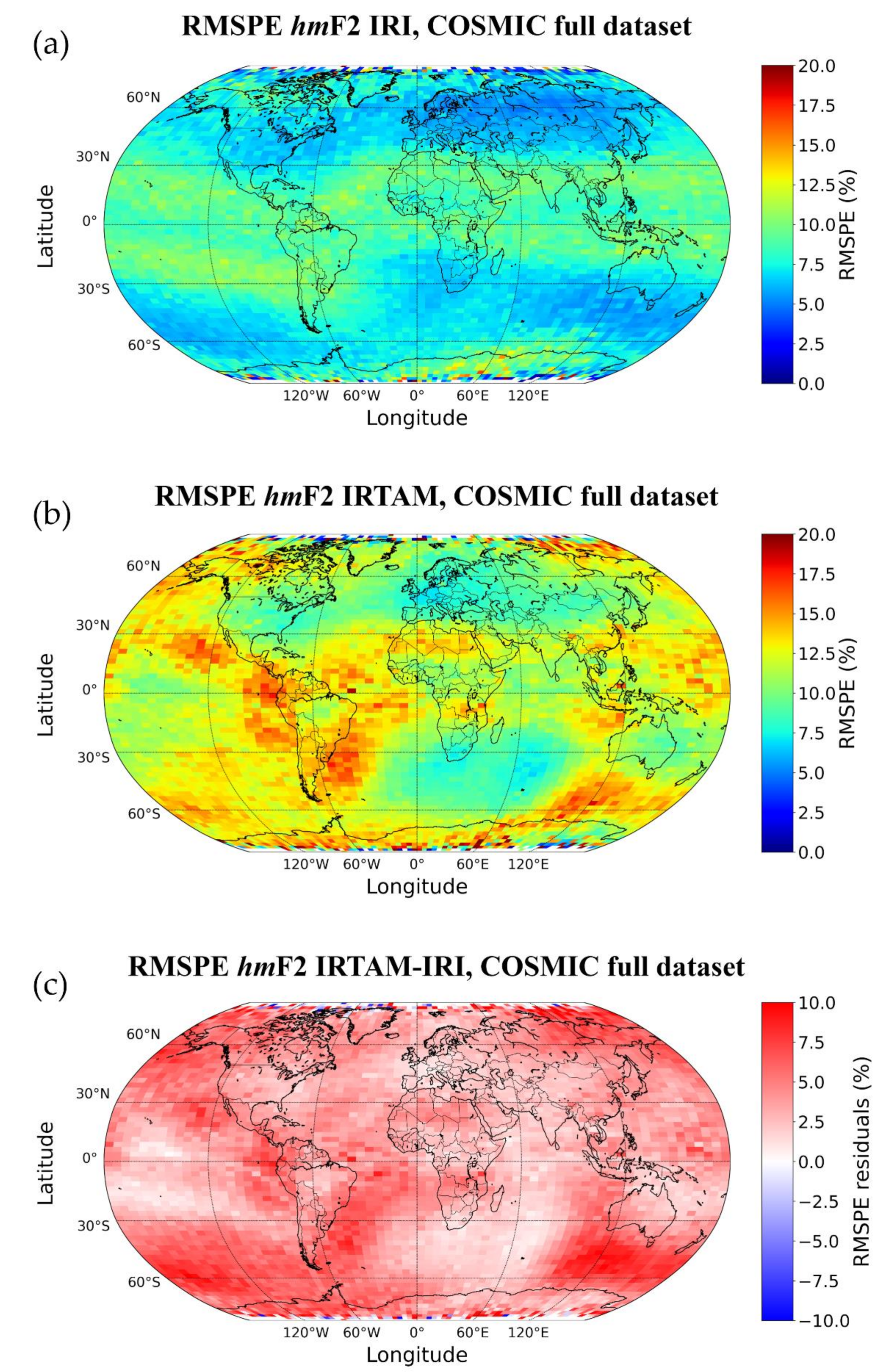
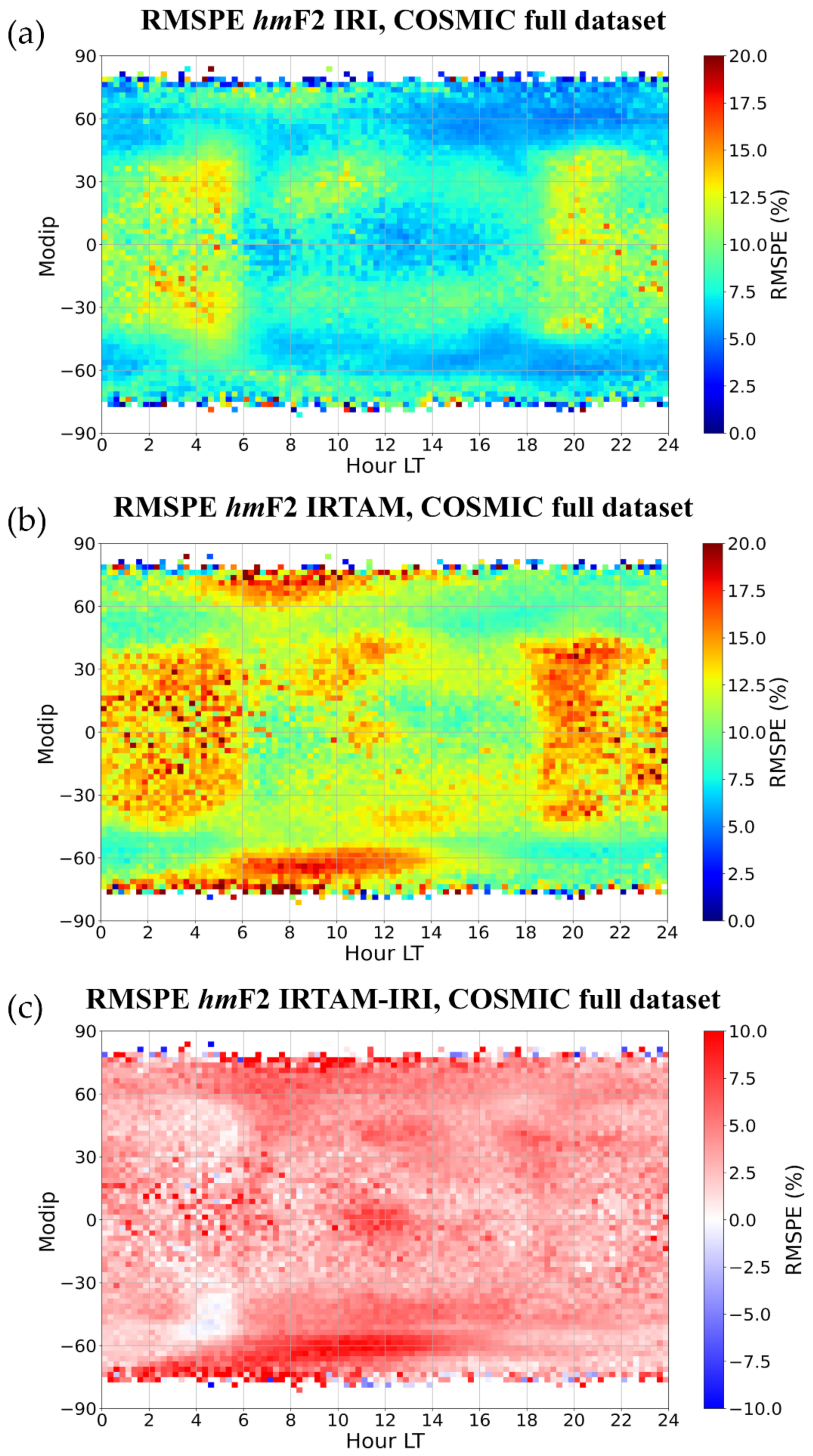

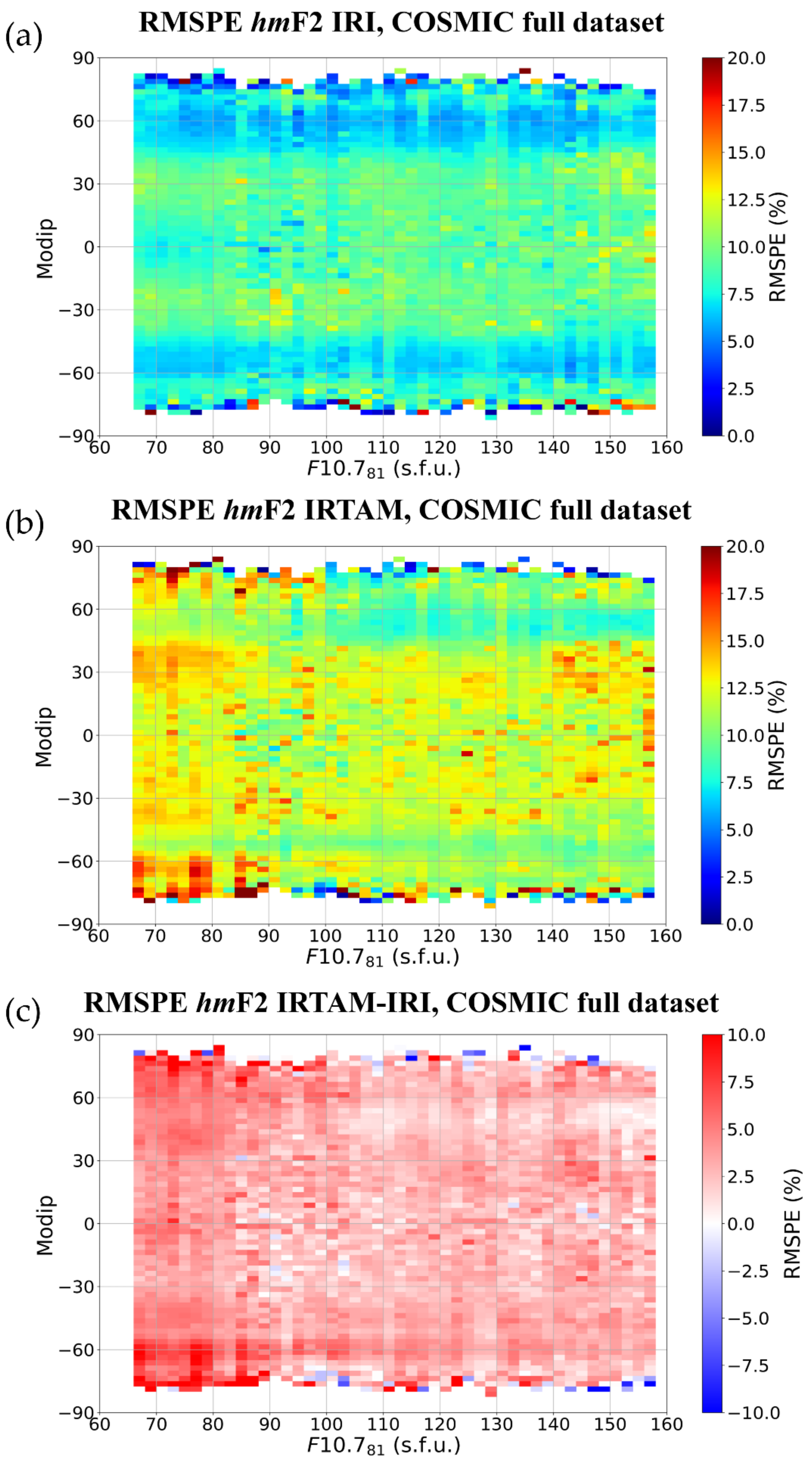
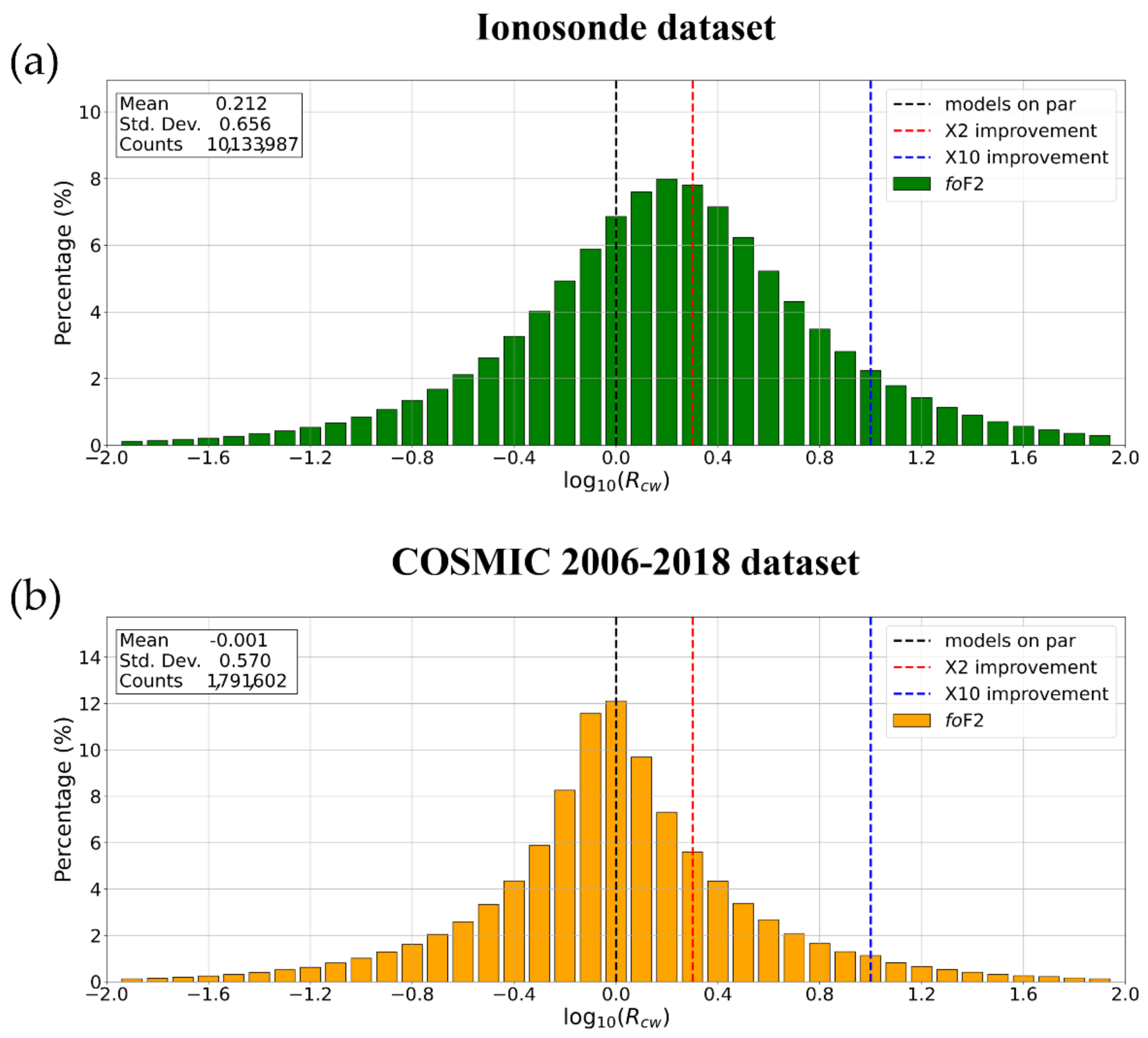
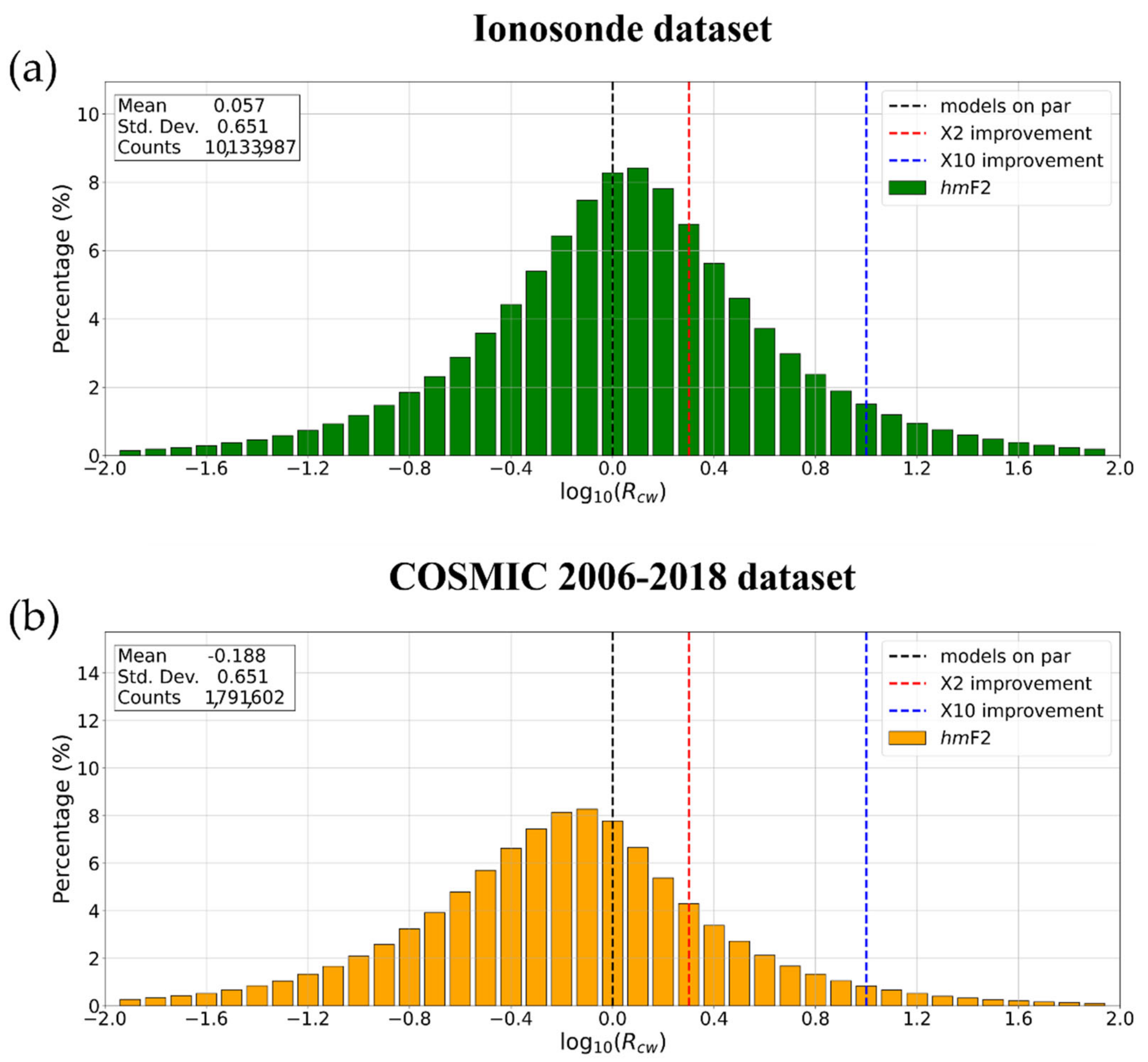
| Number | Ionosonde (Country) | Geographic Latitude [°] | Geographic Longitude [°] | Quasi-Dipole Latitude [°] | Modip [°] | Years Dataset |
|---|---|---|---|---|---|---|
| 1 | Anyang (South Korea) | 37.4° N | 126.9° E | 31.0° N | 46.3° N | 2000–2009 |
| I-Cheon (South Korea) | 37.1° N | 127.5° E | 30.7° N | 46.0° N | 2010–2019 | |
| 2 | Ascension Island (UK) | 7.9° S | 14.4° W | 19.1° S | 34.3° S | 2000–2019 |
| 3 | Athens (Greece) | 38.0° N | 23.5° E | 31.9° N | 46.7° N | 2002–2019 |
| 4 | Boa Vista (Cape Verde) | 2.8° N | 60.7° W | 10.6° N | 19.5° N | 2013–2019 |
| 5 | Boulder (USA) | 40.0° N | 105.3° W | 38.1° N | 53.0° N | 2004–2019 |
| 6 | Cachoeira Paulista (Brazil) | 22.7° S | 45.0° W | 18.8° S | 32.2° S | 2000–2019 |
| 7 | Chilton (U.K.) | 51.5° N | 0.6° W | 47.7° N | 55.6° N | 2000–2019 |
| 8 | Dourbes (Belgium) | 50.1° N | 4.6° E | 45.8° N | 54.8° N | 2001–2019 |
| 9 | Dyess AFB (USA) | 32.4° N | 99.8° W | 41.5° N | 49.2° N | 2000–2009 |
| 10 | Eielson (USA) | 64.7° N | 147.1° W | 64.9° N | 64.1° N | 2012–2019 |
| 11 | El Arenosillo (Spain) | 37.1° N | 6.7° W | 30.5° N | 44.8° N | 2000–2019 |
| 12 | Fortaleza (Brazil) | 3.9° S | 38.4° W | 7.1° S | 13.6° S | 2001–2019 |
| 13 | Gakona (USA) | 62.4° N | 145.0° W | 63.0° N | 62.8° N | 2000–2019 |
| 14 | Goose Bay (Canada) | 53.3° N | 60.3° W | 60.2° N | 58.9° N | 2000–2010 |
| 15 | Grahamstown (South Africa) | 33.3° S | 26.5° E | 41.9° S | 50.3° S | 2000–2019 |
| 16 | Guam (USA) | 13.6° N | 144.9° E | 6.1° N | 12.3° N | 2012–2019 |
| 17 | Hermanus (South Africa) | 34.4° S | 19.2° E | 42.5° S | 51.0° S | 2008–2019 |
| 18 | Jicamarca (Peru) | 12.0° S | 76.8° W | 0.2° N | 0.4° N | 2000–2019 |
| 19 | Juliusruh (Germany) | 54.6° N | 13.4° E | 50.7° N | 57.7° N | 2001–2019 |
| 20 | King Salmon (USA) | 58.4° N | 156.4° W | 56.8° N | 59.8° N | 2000–2012 |
| 21 | Kwajalein (Marshall Islands) | 9.0° N | 167.2° E | 4.1° N | 7.6° N | 2004–2013 |
| 22 | Learmonth (Australia) | 21.8° S | 114.1° E | 29.6° S | 44.9° S | 2001–2019 |
| 23 | Louisvale (South Africa) | 28.5° S | 21.2° E | 38.3° S | 49.7° S | 2000–2019 |
| 24 | Millstone Hill (USA) | 42.6° N | 71.5° W | 51.8° N | 54.2° N | 2000–2019 |
| 25 | Moscow (Russia) | 55.5° N | 37.3° E | 51.5° N | 58.6° N | 2008–2019 |
| 26 | Nicosia (Cyprus) | 35.0° N | 33.2° E | 29.2° N | 44.6° N | 2008–2019 |
| 27 | Nord Greenland (Greenland) | 81.4° N | 17.5° W | 81.0° N | 75.2° N | 2006–2013 |
| 28 | Norilsk (Russia) | 69.2° N | 88.0° E | 64.7° N | 67.5° N | 2002–2015 |
| 29 | Point Arguello (USA) | 34.8° N | 120.5° W | 40.2° N | 48.8° N | 2000–2019 |
| 30 | Port Stanley (Falkland Islands) | 51.6° S | 57.9° W | 38.7° S | 48.3° S | 2000–2019 |
| 31 | Pruhonice (Czech Republic) | 50.0° N | 14.6° E | 45.4° N | 54.9° N | 2004–2019 |
| 32 | Ramey (Puerto Rico) | 18.5° N | 67.1° W | 27.5° N | 38.9° N | 2000–2019 |
| 33 | Rome (Italy) | 41.8° N | 12.5° E | 35.9° N | 49.3° N | 2000–2019 |
| 34 | Roquetes (Spain) | 40.8° N | 0.5° E | 34.7° N | 48.2° N | 2000–2019 |
| 35 | San Vito (Italy) | 40.6° N | 17.8° E | 34.6° N | 48.6° N | 2000–2019 |
| 36 | Sao Luis (Brazil) | 2.6° S | 44.2° W | 2.9° S | 5.0° S | 2000–2019 |
| 37 | Sondrestrom (Greenland) | 67.0° N | 50.9° W | 72.2° N | 65.8° N | 2000–2012 |
| 38 | Thule (Greenland) | 77.5° N | 69.2° W | 84.5° N | 72.7° N | 2000–2014 |
| 39 | Tromso (Norway) | 69.6° N | 19.2° E | 66.5° N | 66.6° N | 2000–2018 |
| 40 | Wallops Island (USA) | 37.9° N | 75.5° W | 47.8° N | 52.0° N | 2000–2019 |
| Ionosonde Stations Dataset | Model | Res. Mean [MHz] | RMSE [MHz] | NRMSE [%] | R | Counts |
|---|---|---|---|---|---|---|
| Daytime | IRI | −0.048 | 1.026 | 14.861 | 0.887 | 4,091,455 |
| IRTAM | −0.015 | 0.676 | 9.789 | 0.952 | ||
| Nighttime | IRI | 0.125 | 1.003 | 23.790 | 0.842 | 4,198,762 |
| IRTAM | 0.013 | 0.674 | 15.983 | 0.930 | ||
| Solar terminator | IRI | 0.106 | 0.946 | 18.011 | 0.885 | 1,843,770 |
| IRTAM | 0.032 | 0.668 | 12.721 | 0.944 | ||
| March Equinox | IRI | 0.179 | 1.040 | 18.129 | 0.914 | 2,710,599 |
| IRTAM | 0.015 | 0.685 | 11.934 | 0.963 | ||
| June Solstice | IRI | −0.033 | 0.919 | 17.038 | 0.880 | 2,255,233 |
| IRTAM | 0.003 | 0.646 | 11.967 | 0.942 | ||
| September Equinox | IRI | −0.002 | 1.008 | 18.216 | 0.906 | 2,644,252 |
| IRTAM | 0.000 | 0.665 | 12.008 | 0.959 | ||
| December Solstice | IRI | 0.046 | 1.205 | 19.493 | 0.918 | 2,523,903 |
| IRTAM | 0.002 | 0.695 | 13.210 | 0.962 | ||
| LSA | IRI | 0.130 | 0.853 | 19.015 | 0.879 | 3,782,579 |
| IRTAM | −0.028 | 0.590 | 13.151 | 0.936 | ||
| MSA | IRI | 0.046 | 0.993 | 18.117 | 0.890 | 3,801,672 |
| IRTAM | 0.007 | 0.665 | 12.135 | 0.953 | ||
| HSA | IRI | −0.057 | 1.202 | 17.180 | 0.896 | 2,549,736 |
| IRTAM | 0.050 | 0.792 | 11.327 | 0.957 | ||
| Quiet magnetic activity | IRI | 0.056 | 0.981 | 17.957 | 0.910 | 9,147,468 |
| IRTAM | 0.006 | 0.655 | 11.995 | 0.960 | ||
| Moderate magnetic activity | IRI | 0.015 | 1.167 | 20.322 | 0.890 | 959,046 |
| IRTAM | −0.007 | 0.814 | 14.171 | 0.949 | ||
| Disturbed magnetic activity | IRI | −0.065 | 1.682 | 27.107 | 0.826 | 27,473 |
| IRTAM | −0.015 | 1.174 | 18.932 | 0.921 | ||
| Full dataset | IRI | 0.051 | 1.002 | 18.258 | 0.908 | 10,133,987 |
| IRTAM | 0.005 | 0.674 | 12.270 | 0.959 |
| Ionosonde (Country) | Model | Res. Mean [MHz] | RMSE [MHz] | NRMSE [%] | R | Counts |
|---|---|---|---|---|---|---|
| Anyang and I-Cheon (South Korea) | IRI | −0.164 | 0.891 | 14.310 | 0.926 | 201,558 |
| IRTAM | −0.104 | 0.656 | 10.514 | 0.961 | ||
| Ascension Island (UK) | IRI | −0.217 | 1.683 | 21.457 | 0.870 | 264,916 |
| IRTAM | 0.289 | 1.352 | 17.240 | 0.933 | ||
| Athens (Greece) | IRI | −0.770 | 1.503 | 30.079 | 0.845 | 313,227 |
| IRTAM | −0.179 | 0.661 | 13.235 | 0.942 | ||
| Boa Vista (Cape Verde) | IRI | 0.364 | 1.634 | 18.484 | 0.868 | 60,295 |
| IRTAM | 0.326 | 1.031 | 11.655 | 0.952 | ||
| Boulder (USA) | IRI | 0.137 | 0.794 | 17.257 | 0.900 | 420,504 |
| IRTAM | −0.013 | 0.564 | 12.255 | 0.949 | ||
| Cachoeira Paulista (Brazil) | IRI | −0.193 | 1.416 | 21.012 | 0.895 | 158,881 |
| IRTAM | 0.101 | 0.944 | 14.010 | 0.955 | ||
| Chilton (U.K.) | IRI | 0.111 | 0.851 | 16.945 | 0.914 | 269,815 |
| IRTAM | 0.037 | 0.641 | 12.765 | 0.951 | ||
| Dourbes (Belgium) | IRI | 0.272 | 0.781 | 15.842 | 0.912 | 328,740 |
| IRTAM | 0.097 | 0.488 | 9.907 | 0.965 | ||
| Dyess AFB (USA) | IRI | 0.197 | 0.988 | 18.951 | 0.895 | 142,345 |
| IRTAM | −0.004 | 0.729 | 13.979 | 0.936 | ||
| Eielson (USA) | IRI | 0.200 | 0.741 | 14.212 | 0.878 | 54,960 |
| IRTAM | 0.040 | 0.436 | 8.366 | 0.956 | ||
| El Arenosillo (Spain) | IRI | −0.149 | 0.987 | 17.429 | 0.908 | 206,362 |
| IRTAM | −0.167 | 0.653 | 11.531 | 0.963 | ||
| Fortaleza (Brazil) | IRI | −0.271 | 1.453 | 19.349 | 0.844 | 115,951 |
| IRTAM | −0.151 | 0.965 | 12.847 | 0.937 | ||
| Gakona (USA) | IRI | −0.033 | 0.789 | 16.965 | 0.886 | 188,948 |
| IRTAM | −0.128 | 0.568 | 12.198 | 0.945 | ||
| Goose Bay (Canada) | IRI | 0.225 | 0.784 | 16.981 | 0.882 | 138,063 |
| IRTAM | −0.138 | 0.619 | 13.394 | 0.926 | ||
| Grahamstown (South Africa) | IRI | 0.263 | 0.923 | 17.213 | 0.937 | 389,105 |
| IRTAM | 0.010 | 0.541 | 10.087 | 0.976 | ||
| Guam (USA) | IRI | −0.200 | 1.232 | 15.569 | 0.880 | 150,696 |
| IRTAM | 0.036 | 0.923 | 11.661 | 0.938 | ||
| Hermanus (South Africa) | IRI | 0.380 | 0.938 | 17.344 | 0.930 | 297,534 |
| IRTAM | 0.053 | 0.496 | 9.173 | 0.977 | ||
| Jicamarca (Peru) | IRI | −0.245 | 1.258 | 17.802 | 0.866 | 379,962 |
| IRTAM | 0.068 | 0.828 | 11.719 | 0.945 | ||
| Juliusruh (Germany) | IRI | 0.140 | 0.822 | 16.308 | 0.923 | 473,533 |
| IRTAM | 0.042 | 0.557 | 11.049 | 0.965 | ||
| King Salmon (USA) | IRI | 0.131 | 0.771 | 18.513 | 0.859 | 180,833 |
| IRTAM | 0.065 | 0.583 | 14.008 | 0.924 | ||
| Kwajalein (Marshall Islands) | IRI | −0.338 | 1.346 | 19.961 | 0.857 | 160,301 |
| IRTAM | 0.032 | 0.953 | 14.135 | 0.933 | ||
| Learmonth (Australia) | IRI | 0.170 | 0.951 | 16.597 | 0.904 | 262,583 |
| IRTAM | −0.124 | 0.629 | 10.985 | 0.962 | ||
| Louisvale (South Africa) | IRI | 0.346 | 1.050 | 17.327 | 0.936 | 191,705 |
| IRTAM | 0.065 | 0.565 | 9.329 | 0.979 | ||
| Millstone Hill (USA) | IRI | 0.093 | 0.879 | 16.280 | 0.918 | 441,837 |
| IRTAM | 0.011 | 0.641 | 11.861 | 0.957 | ||
| Moscow (Russia) | IRI | 0.163 | 0.768 | 15.995 | 0.920 | 301,375 |
| IRTAM | 0.052 | 0.481 | 10.020 | 0.968 | ||
| Nicosia (Cyprus) | IRI | −0.296 | 0.938 | 15.395 | 0.928 | 110,598 |
| IRTAM | −0.116 | 0.645 | 10.591 | 0.965 | ||
| Nord Greenland (Greenland) | IRI | 0.066 | 0.771 | 20.584 | 0.745 | 47,039 |
| IRTAM | −0.191 | 0.653 | 17.428 | 0.839 | ||
| Norilsk (Russia) | IRI | 0.115 | 0.737 | 17.516 | 0.836 | 145,454 |
| IRTAM | −0.051 | 0.357 | 8.481 | 0.963 | ||
| Point Arguello (USA) | IRI | 0.158 | 0.907 | 16.580 | 0.913 | 377,422 |
| IRTAM | 0.017 | 0.573 | 10.481 | 0.965 | ||
| Port Stanley (Falkland Islands) | IRI | −0.512 | 1.247 | 23.169 | 0.887 | 212,867 |
| IRTAM | −0.040 | 0.745 | 13.854 | 0.953 | ||
| Pruhonice (Czech Republic) | IRI | 0.274 | 0.775 | 15.527 | 0.913 | 396,878 |
| IRTAM | 0.092 | 0.498 | 9.971 | 0.963 | ||
| Ramey (Puerto Rico) | IRI | 0.019 | 1.239 | 19.490 | 0.870 | 231,544 |
| IRTAM | 0.003 | 0.786 | 12.366 | 0.950 | ||
| Rome (Italy) | IRI | −0.100 | 0.900 | 15.741 | 0.924 | 520,519 |
| IRTAM | −0.089 | 0.711 | 12.450 | 0.953 | ||
| Roquetes (Spain) | IRI | −0.013 | 0.829 | 15.010 | 0.923 | 443,895 |
| IRTAM | −0.069 | 0.601 | 10.889 | 0.961 | ||
| San Vito (Italy) | IRI | 0.097 | 0.808 | 15.058 | 0.920 | 372,074 |
| IRTAM | 0.020 | 0.602 | 11.211 | 0.956 | ||
| Sao Luis (Brazil) | IRI | −0.157 | 1.403 | 19.002 | 0.843 | 122,965 |
| IRTAM | −0.045 | 0.992 | 13.433 | 0.928 | ||
| Sondrestrom (Greenland) | IRI | 0.540 | 0.977 | 20.860 | 0.812 | 200,111 |
| IRTAM | 0.138 | 0.650 | 13.864 | 0.885 | ||
| Thule (Greenland) | IRI | 0.610 | 0.967 | 22.536 | 0.767 | 278,374 |
| IRTAM | 0.135 | 0.561 | 13.072 | 0.886 | ||
| Tromso (Norway) | IRI | −0.009 | 0.764 | 18.261 | 0.845 | 259,000 |
| IRTAM | −0.134 | 0.529 | 12.659 | 0.932 | ||
| Wallops Island (USA) | IRI | 0.211 | 0.870 | 16.679 | 0.912 | 321,218 |
| IRTAM | 0.068 | 0.628 | 12.051 | 0.953 |
| COSMIC Dataset | Model | Res. Mean [MHz] | RMSE [MHz] | NRMSE [%] | R | Counts |
|---|---|---|---|---|---|---|
| Daytime | IRI | 0.012 | 1.058 | 14.841 | 0.891 | 998,544 |
| IRTAM | 0.048 | 1.127 | 15.801 | 0.875 | ||
| Nighttime | IRI | 0.126 | 1.076 | 21.781 | 0.856 | 422,509 |
| IRTAM | 0.172 | 1.157 | 23.424 | 0.834 | ||
| Solar terminator | IRI | 0.146 | 1.014 | 17.872 | 0.883 | 370,549 |
| IRTAM | 0.136 | 1.059 | 18.672 | 0.871 | ||
| March Equinox | IRI | 0.332 | 1.157 | 17.291 | 0.911 | 454,118 |
| IRTAM | 0.257 | 1.188 | 17.754 | 0.902 | ||
| June Solstice | IRI | −0.068 | 0.917 | 15.715 | 0.898 | 439,417 |
| IRTAM | −0.021 | 0.985 | 16.870 | 0.881 | ||
| September Equinox | IRI | −0.044 | 1.044 | 16.724 | 0.908 | 447,872 |
| IRTAM | 0.056 | 1.080 | 17.304 | 0.900 | ||
| December Solstice | IRI | 0.041 | 1.077 | 16.665 | 0.888 | 450,195 |
| IRTAM | 0.085 | 1.210 | 18.721 | 0.859 | ||
| LSA | IRI | −0.085 | 0.899 | 17.064 | 0.879 | 750,993 |
| IRTAM | −0.233 | 1.000 | 18.972 | 0.859 | ||
| MSA | IRI | 0.080 | 1.075 | 16.357 | 0.891 | 608,461 |
| IRTAM | 0.180 | 1.092 | 16.613 | 0.890 | ||
| HSA | IRI | 0.312 | 1.252 | 16.142 | 0.891 | 432,148 |
| IRTAM | 0.547 | 1.337 | 17.237 | 0.890 | ||
| Quiet magnetic activity | IRI | 0.061 | 1.043 | 16.561 | 0.902 | 1,660,108 |
| IRTAM | 0.090 | 1.111 | 17.643 | 0.888 | ||
| Moderate magnetic activity | IRI | 0.138 | 1.176 | 18.046 | 0.895 | 129,917 |
| IRTAM | 0.159 | 1.232 | 18.897 | 0.885 | ||
| Disturbed magnetic activity | IRI | 0.165 | 1.561 | 21.840 | 0.841 | 1577 |
| IRTAM | 0.251 | 1.537 | 21.500 | 0.851 | ||
| Low Modip | IRI | −0.422 | 1.373 | 17.518 | 0.872 | 267,449 |
| IRTAM | −0.254 | 1.481 | 18.902 | 0.844 | ||
| Mid Modip | IRI | 0.139 | 1.036 | 16.496 | 0.903 | 1,230,835 |
| IRTAM | 0.168 | 1.100 | 17.521 | 0.890 | ||
| High Modip | IRI | 0.208 | 0.746 | 14.746 | 0.861 | 293,318 |
| IRTAM | 0.107 | 0.766 | 15.129 | 0.842 | ||
| Full dataset | IRI | 0.067 | 1.053 | 16.688 | 0.901 | 1,791,602 |
| IRTAM | 0.095 | 1.120 | 17.748 | 0.888 |
| Ionosonde Stations Dataset | Model | Res. Mean [km] | RMSE [km] | NRMSE [%] | R | Counts |
|---|---|---|---|---|---|---|
| Daytime | IRI | −6.736 | 27.844 | 11.021 | 0.807 | 4,091,455 |
| IRTAM | −3.142 | 24.745 | 9.794 | 0.855 | ||
| Nighttime | IRI | 10.293 | 38.663 | 12.625 | 0.580 | 4,198,762 |
| IRTAM | 0.428 | 31.143 | 10.170 | 0.745 | ||
| Solar terminator | IRI | 1.424 | 29.298 | 11.088 | 0.722 | 1,843,770 |
| IRTAM | −2.901 | 27.034 | 10.231 | 0.784 | ||
| March Equinox | IRI | 2.693 | 30.997 | 11.096 | 0.788 | 2,710,599 |
| IRTAM | −1.338 | 26.225 | 9.388 | 0.859 | ||
| June Solstice | IRI | −5.670 | 34.761 | 12.768 | 0.743 | 2,255,233 |
| IRTAM | −2.196 | 29.699 | 10.908 | 0.825 | ||
| September Equinox | IRI | 1.607 | 30.758 | 11.154 | 0.784 | 2,644,252 |
| IRTAM | −1.798 | 26.638 | 9.660 | 0.849 | ||
| December Solstice | IRI | 7.735 | 35.608 | 12.723 | 0.765 | 2,523,903 |
| IRTAM | −1.217 | 29.494 | 10.539 | 0.844 | ||
| LSA | IRI | 1.581 | 32.216 | 12.481 | 0.725 | 3,782,579 |
| IRTAM | −2.231 | 28.479 | 11.034 | 0.804 | ||
| MSA | IRI | 4.591 | 33.831 | 12.081 | 0.736 | 3,801,672 |
| IRTAM | −0.750 | 28.283 | 10.100 | 0.829 | ||
| HSA | IRI | −2.019 | 32.867 | 10.943 | 0.757 | 2,549,736 |
| IRTAM | −2.006 | 26.689 | 8.886 | 0.853 | ||
| Quiet magnetic activity | IRI | 0.682 | 31.877 | 11.593 | 0.772 | 9,147,468 |
| IRTAM | −1.580 | 27.402 | 9.966 | 0.845 | ||
| Moderate magnetic activity | IRI | 11.754 | 41.017 | 13.914 | 0.720 | 959,046 |
| IRTAM | −1.983 | 32.279 | 10.950 | 0.832 | ||
| Disturbed magnetic activity | IRI | 28.087 | 66.786 | 20.793 | 0.595 | 27,473 |
| IRTAM | −1.683 | 45.640 | 14.210 | 0.807 | ||
| Full dataset | IRI | 1.804 | 32.993 | 11.912 | 0.766 | 10,133,987 |
| IRTAM | −1.619 | 27.965 | 10.097 | 0.845 |
| Ionosonde (Country) | Model | Res. Mean [km] | RMSE [km] | NRMSE [%] | R | Counts |
|---|---|---|---|---|---|---|
| Anyang and I-Cheon (South Korea) | IRI | −0.211 | 29.869 | 10.995 | 0.779 | 201,558 |
| IRTAM | −1.389 | 30.911 | 11.379 | 0.794 | ||
| Ascension Island (UK) | IRI | 0.826 | 34.775 | 12.186 | 0.638 | 264,916 |
| IRTAM | −2.158 | 32.434 | 11.366 | 0.784 | ||
| Athens (Greece) | IRI | −4.951 | 33.230 | 12.370 | 0.716 | 313,227 |
| IRTAM | −6.015 | 26.230 | 9.765 | 0.851 | ||
| Boa Vista (Cape Verde) | IRI | −6.362 | 35.615 | 11.520 | 0.736 | 60,295 |
| IRTAM | 3.007 | 26.703 | 8.637 | 0.852 | ||
| Boulder (USA) | IRI | 4.083 | 29.890 | 11.126 | 0.763 | 420,504 |
| IRTAM | −3.033 | 25.579 | 9.522 | 0.836 | ||
| Cachoeira Paulista (Brazil) | IRI | 16.579 | 45.903 | 15.790 | 0.499 | 158,881 |
| IRTAM | 8.994 | 32.261 | 11.097 | 0.789 | ||
| Chilton (U.K.) | IRI | −3.192 | 29.583 | 10.891 | 0.831 | 269,815 |
| IRTAM | −7.850 | 28.018 | 10.315 | 0.861 | ||
| Dourbes (Belgium) | IRI | 0.887 | 25.512 | 9.526 | 0.845 | 328,740 |
| IRTAM | −1.512 | 21.726 | 8.112 | 0.889 | ||
| Dyess AFB (USA) | IRI | 3.456 | 36.564 | 13.355 | 0.708 | 142,345 |
| IRTAM | −5.363 | 32.746 | 11.961 | 0.785 | ||
| Eielson (USA) | IRI | −15.912 | 28.692 | 11.911 | 0.759 | 54,960 |
| IRTAM | −8.381 | 24.055 | 9.986 | 0.817 | ||
| El Arenosillo (Spain) | IRI | 11.753 | 30.989 | 10.907 | 0.792 | 206,362 |
| IRTAM | 7.118 | 24.843 | 8.744 | 0.866 | ||
| Fortaleza (Brazil) | IRI | 3.462 | 41.126 | 13.206 | 0.725 | 115,951 |
| IRTAM | 9.718 | 34.957 | 11.225 | 0.832 | ||
| Gakona (USA) | IRI | −12.830 | 36.554 | 14.376 | 0.729 | 188,948 |
| IRTAM | −15.801 | 35.878 | 14.110 | 0.784 | ||
| Goose Bay (Canada) | IRI | 5.420 | 36.757 | 13.826 | 0.792 | 138,063 |
| IRTAM | 3.144 | 34.465 | 12.964 | 0.801 | ||
| Grahamstown (South Africa) | IRI | 2.539 | 25.744 | 9.616 | 0.764 | 389,105 |
| IRTAM | −2.788 | 23.069 | 8.617 | 0.825 | ||
| Guam (USA) | IRI | −15.517 | 36.903 | 12.338 | 0.700 | 150,696 |
| IRTAM | −2.786 | 27.130 | 9.071 | 0.860 | ||
| Hermanus (South Africa) | IRI | 3.261 | 21.424 | 8.029 | 0.827 | 297,534 |
| IRTAM | −6.104 | 20.670 | 7.746 | 0.862 | ||
| Jicamarca (Peru) | IRI | 4.135 | 41.582 | 12.738 | 0.777 | 379,962 |
| IRTAM | −0.082 | 29.664 | 9.087 | 0.901 | ||
| Juliusruh (Germany) | IRI | 1.661 | 27.765 | 10.207 | 0.837 | 473,533 |
| IRTAM | −1.090 | 23.896 | 8.785 | 0.880 | ||
| King Salmon (USA) | IRI | 31.973 | 62.509 | 20.815 | 0.696 | 180,833 |
| IRTAM | 16.755 | 42.827 | 14.261 | 0.832 | ||
| Kwajalein (Marshall Islands) | IRI | 5.016 | 38.853 | 12.565 | 0.581 | 160,301 |
| IRTAM | −3.969 | 40.814 | 13.199 | 0.747 | ||
| Learmonth (Australia) | IRI | 8.493 | 32.307 | 11.521 | 0.727 | 262,583 |
| IRTAM | −2.128 | 29.816 | 10.633 | 0.805 | ||
| Louisvale (South Africa) | IRI | 1.622 | 25.004 | 9.063 | 0.782 | 191,705 |
| IRTAM | −4.845 | 22.754 | 8.247 | 0.849 | ||
| Millstone Hill (USA) | IRI | −8.326 | 31.833 | 11.904 | 0.779 | 441,837 |
| IRTAM | −6.702 | 27.867 | 10.421 | 0.834 | ||
| Moscow (Russia) | IRI | −3.617 | 22.775 | 8.747 | 0.840 | 301,375 |
| IRTAM | −3.259 | 19.542 | 7.505 | 0.888 | ||
| Nicosia (Cyprus) | IRI | −3.840 | 26.716 | 10.018 | 0.784 | 110,598 |
| IRTAM | −3.482 | 23.631 | 8.861 | 0.853 | ||
| Nord Greenland (Greenland) | IRI | −4.422 | 41.196 | 15.602 | 0.351 | 47,039 |
| IRTAM | −5.385 | 38.360 | 15.528 | 0.530 | ||
| Norilsk (Russia) | IRI | −0.618 | 27.228 | 10.994 | 0.622 | 145,454 |
| IRTAM | −2.677 | 17.375 | 7.015 | 0.873 | ||
| Point Arguello (USA) | IRI | 10.669 | 35.686 | 12.619 | 0.716 | 377,422 |
| IRTAM | 5.099 | 26.358 | 9.321 | 0.854 | ||
| Port Stanley (Falkland Islands) | IRI | −2.350 | 34.875 | 12.103 | 0.805 | 212,867 |
| IRTAM | −4.516 | 28.228 | 9.796 | 0.878 | ||
| Pruhonice (Czech Republic) | IRI | −1.091 | 24.158 | 9.111 | 0.851 | 396,878 |
| IRTAM | −2.741 | 22.586 | 8.518 | 0.874 | ||
| Ramey (Puerto Rico) | IRI | 4.184 | 33.092 | 11.533 | 0.732 | 231,544 |
| IRTAM | 1.407 | 25.776 | 8.983 | 0.851 | ||
| Rome (Italy) | IRI | −5.319 | 27.841 | 10.189 | 0.844 | 520,519 |
| IRTAM | −9.187 | 28.701 | 10.503 | 0.850 | ||
| Roquetes (Spain) | IRI | 3.402 | 23.623 | 8.551 | 0.864 | 443,895 |
| IRTAM | 0.473 | 21.542 | 7.798 | 0.891 | ||
| San Vito (Italy) | IRI | 7.930 | 29.538 | 10.645 | 0.786 | 372,074 |
| IRTAM | 5.167 | 26.355 | 9.497 | 0.844 | ||
| Sao Luis (Brazil) | IRI | 11.516 | 43.761 | 13.375 | 0.694 | 122,965 |
| IRTAM | 6.016 | 34.662 | 10.594 | 0.827 | ||
| Sondrestrom (Greenland) | IRI | 1.676 | 45.625 | 16.934 | 0.537 | 200,111 |
| IRTAM | −3.123 | 40.476 | 15.023 | 0.673 | ||
| Thule (Greenland) | IRI | 12.306 | 47.456 | 16.678 | 0.308 | 278,374 |
| IRTAM | 5.532 | 35.084 | 12.330 | 0.696 | ||
| Tromso (Norway) | IRI | −3.295 | 33.955 | 13.577 | 0.551 | 259,000 |
| IRTAM | −6.586 | 27.803 | 11.118 | 0.749 | ||
| Wallops Island (USA) | IRI | −0.615 | 28.794 | 10.395 | 0.764 | 321,218 |
| IRTAM | 0.698 | 25.755 | 9.298 | 0.833 |
| COSMIC Dataset | Model | Res. Mean [km] | RMSE [km] | NRMSE [%] | R | Counts |
|---|---|---|---|---|---|---|
| Daytime | IRI | 2.766 | 20.065 | 7.498 | 0.898 | 998,544 |
| IRTAM | −0.502 | 31.423 | 11.742 | 0.734 | ||
| Nighttime | IRI | 6.659 | 28.618 | 9.352 | 0.775 | 422,509 |
| IRTAM | 2.581 | 36.554 | 11.945 | 0.588 | ||
| Solar terminator | IRI | 2.980 | 20.424 | 7.509 | 0.863 | 370,549 |
| IRTAM | −0.915 | 28.912 | 10.630 | 0.699 | ||
| March Equinox | IRI | 4.827 | 23.133 | 8.296 | 0.871 | 454,118 |
| IRTAM | 0.621 | 30.988 | 11.114 | 0.748 | ||
| June Solstice | IRI | 1.623 | 21.718 | 7.928 | 0.885 | 439,417 |
| IRTAM | 4.796 | 32.985 | 12.041 | 0.730 | ||
| September Equinox | IRI | 2.934 | 21.552 | 7.864 | 0.884 | 447,872 |
| IRTAM | −2.540 | 30.864 | 11.261 | 0.743 | ||
| December Solstice | IRI | 5.465 | 23.296 | 8.222 | 0.882 | 450,195 |
| IRTAM | −2.225 | 33.969 | 11.990 | 0.713 | ||
| LSA | IRI | 1.291 | 19.834 | 7.677 | 0.863 | 750,993 |
| IRTAM | −4.387 | 31.950 | 12.367 | 0.655 | ||
| MSA | IRI | 5.375 | 23.349 | 8.255 | 0.859 | 608,461 |
| IRTAM | 0.503 | 31.365 | 11.088 | 0.719 | ||
| HSA | IRI | 5.645 | 25.248 | 8.318 | 0.854 | 432,148 |
| IRTAM | 7.495 | 33.846 | 11.151 | 0.721 | ||
| Quiet magnetic activity | IRI | 2.749 | 21.283 | 7.699 | 0.890 | 1,660,108 |
| IRTAM | −0.432 | 31.686 | 11.462 | 0.737 | ||
| Moderate magnetic activity | IRI | 15.854 | 33.382 | 11.454 | 0.808 | 129,917 |
| IRTAM | 7.206 | 38.091 | 13.069 | 0.681 | ||
| Disturbed magnetic activity | IRI | 35.519 | 61.099 | 19.366 | 0.571 | 1577 |
| IRTAM | 19.862 | 56.750 | 17.987 | 0.543 | ||
| Low Modip | IRI | 5.568 | 30.485 | 9.539 | 0.805 | 267,449 |
| IRTAM | 11.235 | 41.462 | 12.973 | 0.648 | ||
| Mid Modip | IRI | 3.666 | 21.098 | 7.746 | 0.874 | 1,230,835 |
| IRTAM | −0.829 | 30.338 | 11.139 | 0.722 | ||
| High Modip | IRI | 2.313 | 19.031 | 7.289 | 0.856 | 293,318 |
| IRTAM | −5.912 | 30.208 | 11.570 | 0.627 | ||
| Full dataset | IRI | 3.728 | 22.446 | 8.087 | 0.881 | 1,791,602 |
| IRTAM | 0.140 | 32.223 | 11.609 | 0.733 |
Publisher’s Note: MDPI stays neutral with regard to jurisdictional claims in published maps and institutional affiliations. |
© 2021 by the authors. Licensee MDPI, Basel, Switzerland. This article is an open access article distributed under the terms and conditions of the Creative Commons Attribution (CC BY) license (https://creativecommons.org/licenses/by/4.0/).
Share and Cite
Pignalberi, A.; Pietrella, M.; Pezzopane, M. Towards a Real-Time Description of the Ionosphere: A Comparison between International Reference Ionosphere (IRI) and IRI Real-Time Assimilative Mapping (IRTAM) Models. Atmosphere 2021, 12, 1003. https://doi.org/10.3390/atmos12081003
Pignalberi A, Pietrella M, Pezzopane M. Towards a Real-Time Description of the Ionosphere: A Comparison between International Reference Ionosphere (IRI) and IRI Real-Time Assimilative Mapping (IRTAM) Models. Atmosphere. 2021; 12(8):1003. https://doi.org/10.3390/atmos12081003
Chicago/Turabian StylePignalberi, Alessio, Marco Pietrella, and Michael Pezzopane. 2021. "Towards a Real-Time Description of the Ionosphere: A Comparison between International Reference Ionosphere (IRI) and IRI Real-Time Assimilative Mapping (IRTAM) Models" Atmosphere 12, no. 8: 1003. https://doi.org/10.3390/atmos12081003
APA StylePignalberi, A., Pietrella, M., & Pezzopane, M. (2021). Towards a Real-Time Description of the Ionosphere: A Comparison between International Reference Ionosphere (IRI) and IRI Real-Time Assimilative Mapping (IRTAM) Models. Atmosphere, 12(8), 1003. https://doi.org/10.3390/atmos12081003






